Freemasonry Today
Comrades and the Craft
The Brothers in Alms photography exhibition
Maritime Masons
Seamasons take the Strategy on board

Freemasonry Today
Comrades and the Craft
The Brothers in Alms photography exhibition
Maritime Masons
Seamasons take the Strategy on board
Grand Secretary Adrian Marsh: steering the success of UGLE’s Strategy

The 1723 Constitutions
Their consequences in Scotland

The official journal of the United Grand Lodge of England Issue 63 – Autumn 2023
Editor Donna HardieEditorial Panel Adrian Marsh, Shaun Butler
Marta Zandri, Robert Frankl, Paul Grier Elliott Chevin, Roger Maber, Richard Barnett Martin Cherry, Guy Roberts

Published by Sunday, 207 Union Street, London SE1 0LN, www.wearesunday.com for the United Grand Lodge of England, Freemasons’ Hall, Great Queen Street, London WC2B 5AZ
Editorial Manager Marta Zandri editor@freemasonrytoday.com
Freemasonry Today, Freemasons’ Hall, Great Queen Street, London WC2B 5AZ
Advertising contact Ethan Hall ethan@square7media.co.uk
020 3832 2879 Square7 Media Ltd, 3 More London Riverside, London SE1 2RE Circulation fmt@freemasonrytoday.com
020 7395 9392
Masonic enquiries editor@freemasonrytoday.com
020 7831 9811 www.ugle.org.uk
Printed by Acorn Web Offset Ltd
© United Grand Lodge of England 2023. The opinions herein are those of the authors or persons interviewed only and do not reflect the views of the United Grand Lodge of England or Sunday.

editor@freemasonrytoday.com

@freemasonry2day

@ugle_grandlodge @grandchapter
FreemasonryToday
UnitedGrandLodgeofEngland
SupremeGrandChapte r
@unitedgrandlodgeofengland
@freemasonrytoday
@freemasonshall
Officer and Claire Bastin as Commercial Director. Richard Jewitt has been promoted to Director of Building Services, and Shaun Butler to Director of Membership and Communications. Fortunately our staff functions have remained stable with Liz Gay as HR Director, Anna Buss as Chief Financial Officer and Donald Taylor as Legal Director. I have high expectations of this new team, and everyone from the department leadership right through the organisation is focused on the members’ experience.
I am always extremely proud when I hear our members commenting positively on how much they enjoy visiting Freemasons’ Hall. Whether it’s the smiling faces from our outstanding front desk and security team, our helpful porters, or a member of the Secretariat who’s gone out of their way to deal with an issue, it’s always cheering to receive the feedback. While I appreciate we don’t always get it right, I very much hope that we always learn from our mistakes and that you feel we are always striving to improve.
The past year certainly feels as though it has gone in the blink of an eye, and while we are now starting to see some progress in the ‘Strong Foundations’ pillar of the Strategy, there is still a lot of work to do. You may already have heard that UGLE is working on a new membership database system currently codenamed Project 2023. This will be a new website and phone app available to every member where you can see and update your own personal contact information. In the first phase it will enable you to see your next meetings coming up within your Lodges and Chapters and add them as reminders to your calendar. There is a host of other functions which will be added to in regular releases with the aim of providing you with easy access to information to enhance your membership.
Dear brethren and companions, I hope you have all had a relaxing break over the summer and are as excited as I am for the new Masonic season. It is now 12 months since I took on the role of Grand Secretary and the Pro Grand Master launched the Seven Year Strategy. During this time, we have also had a change in leadership of the Board of General Purposes, with Michael Ward taking over from Geoffrey Dearing as President and Jonathan Whitaker taking over from Michael as Deputy President. The senior leadership team at UGLE has also changed, with Oliver Coddington joining full-time as Head of Secretariat, Hugh Douglas-Smith joining as Chief Information
The system will be released at the end of the first quarter of 2024 and will be available to all members. The intention is, over time, to build a membership system to meet all the needs of UGLE, London, Provinces, Districts and individual units, with the member and the member experience at the heart of it.
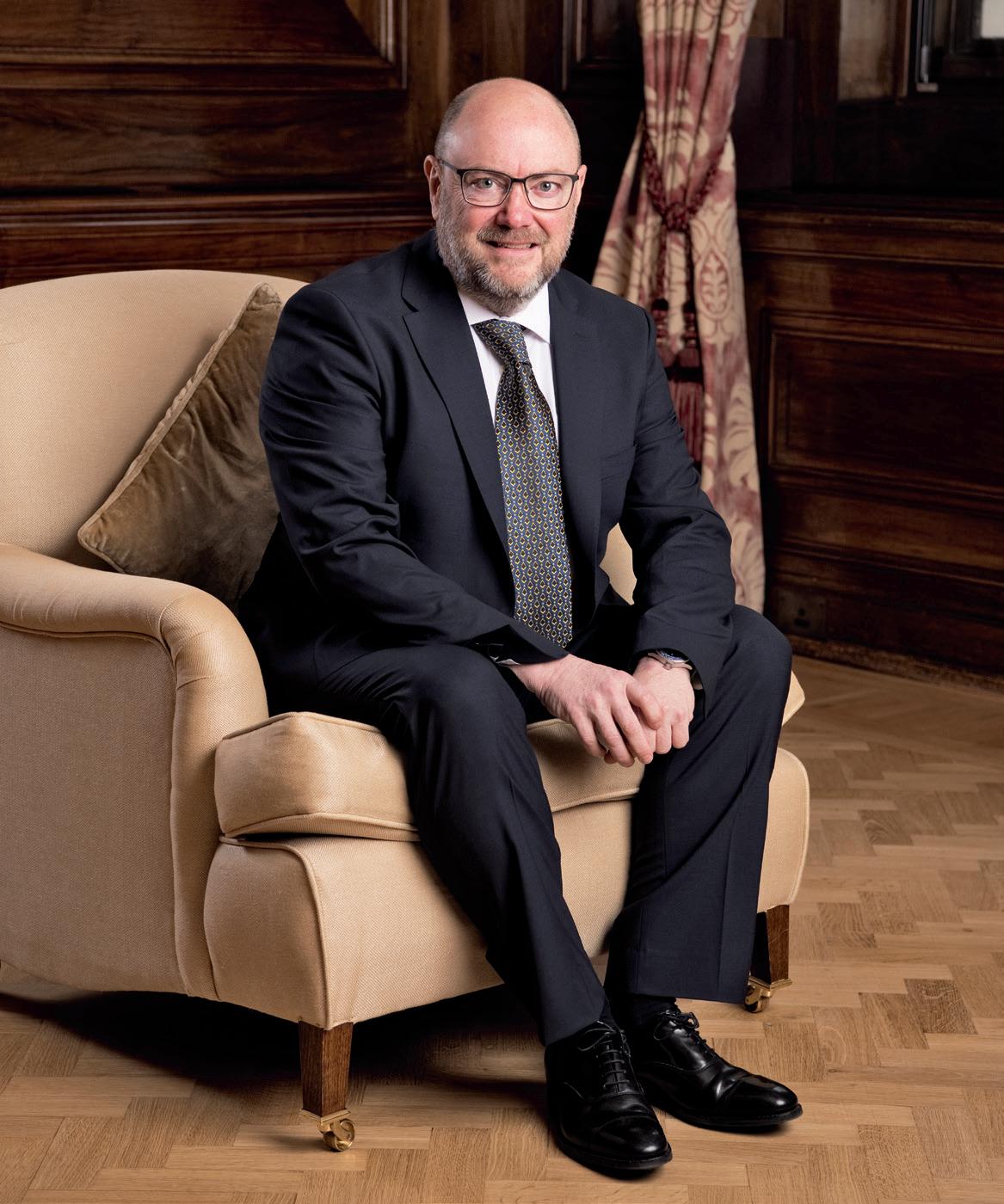
Without wishing to get too technical, our current system is based on an Oracle database, and is called ADelphi. In addition to ADelphi, we also have an application called Hermes which has been rolled out to a number of Provinces, Districts and their respective Lodges and Chapters. Where Hermes is used, it eliminates the paper forms associated with joining and certain other processes within the Lodge/Chapter.
We took the decision to halt the roll-out of Hermes during the latter half of 2022. This was due to a number of issues identified by those Provinces that were live, and a growing list of support issues that were swamping
the support team at UGLE. Our CIO Hugh DouglasSmith joined at the end of November 2022, having experienced first-hand the roll-out of Hermes within his Province of Buckinghamshire, where at the time he was the Deputy Provincial Grand Master.
At the same time, we became aware that Oracle was planning to remove support from one of the critical areas of ADelphi. The cost of upgrading was prohibitive and alternatives were researched. I am pleased to report that an alternative technology has been selected that will enable us to offer a far better user experience to everyone, as well as to manage our data more effectively and at considerably less cost than is at present necessary with the annual maintenance and licence costs of Oracle.
A working group of both technical and core users was formed and plans grew, both to address the issues with Hermes and to futureproof our systems. These plans were revealed in April and, since then, work has continued with a series of regional workshops where more than 120 Freemasons from London, Provinces and Districts have been involved. As a result, we are now entering the initial build of a brand new membership system. You will hear a lot more about this later in the year and in future editions of FMT but, essentially, from the day of release it will be available to all members as a phone app or via a website should they choose to use it.
In parallel, having released two major updates to Hermes, we plan to resume the roll-out towards the end of this year but with a much more manageable plan. Those Provinces that will form part of this schedule will be approached soon to start a new and revised training programme.
Hermes has demonstrated that where it is used, it is a very beneficial tool for Lodge Secretaries and Scribes E and provides far quicker reporting of membership information than the paper-based forms it replaces. Gradually, over time, its functionality, as well as that of ADelphi, will be replicated within the new membership system. It is, therefore, envisaged that by the time we approach the larger Provinces in the schedule for Hermes roll-out, its requirement will have been superseded by the new system.
It is an exciting time and we are indebted to the great IT team within UGLE and a large number of our members who are working to make this happen. We are actively communicating with teams within the Provinces to ensure we take the best of what is available and encompass new ideas into later phases of the project. If you have any experience or ideas, we would be pleased to hear from you, particularly in the areas of user interface and user experience (UI/UX). You can email me at GrandSecretary@ugle.org.uk with your suggestions.
It has also been an interesting Masonic year for me personally, having been installed into the Chair of Lodge Sine Nomine No. 10,000 – more than 25 years since I had my only other experience in the Chair at Strong Man Lodge No. 45. I have had the privilege to welcome both my son and my son-in-law into Freemasonry and also to be present when the Deputy Grand Secretary, Graham Redman, received his 50-year certificate in a double act by the Pro Grand Master and the Metropolitan Grand Master!
I would like to conclude by reflecting on the Pro Grand Master’s call for us all to be innovative and adopt a ‘Yes If’ approach rather than ‘No Because’. The holding of a Quarterly Communication outside London is a great example of this and the numbers supporting it have validated the decision to try something different. In my Mother Lodge, Strong Man, I was delighted to see a committee formed which specifically looked at how to innovate. This resulted in meetings starting at 5.30pm or 6.00pm, and multiple candidates, which if anyone had suggested when I was a new Freemason really would have resulted in personal violence! There is, however, no magic wand that can be waved at UGLE or Provincial level to deliver the Seven Year Strategy; it really does come down to individual Lodges and Chapters deciding to accept the challenge. The message is, brethren, ‘it’s your Lodge, it’s your future’.
Adrian Marsh Grand Secretary‘I have high expectations of this new team, and everyone from the department leadership right through the organisation is focused on the members’ experience’
The Province of Hampshire & Isle of Wight supports a strong community of around 8,000 Freemasons meeting in 250 Lodges. It is also home to one of the largest and internationally famous boating communities. The Solent – a narrow strait between the Isle of Wight and mainland England – boasts stunning natural scenery, safe anchorages and ideal sailing conditions. It’s estimated that more than 20,000 yachts and motorboats regularly use the area for recreation.
In 2016, a group of local Freemasons decided to combine their love of sailing and boats with their interest in Freemasonry to form the specialist
Spinnaker Lodge No. 9932. The aim was to take Freemasonry out to the sailing community by holding three summer meetings in Masonic centres close to the marinas. Friends and partners of Lodge members were invited along for a post-meeting dinner at one of the local yacht clubs.
Over the years, the Spinnaker wives and girlfriends, or ‘SWAGS’ as they are affectionately known, have become firm friends. They have their own WhatsApp group and hold an annual SWAGS dinner on the night of the Lodge Installation meeting in November.
The summer meetings are weekend affairs where many of the 28 boats owned by Lodge members arrive

UGLE’s Strategy emphasises the importance of creating an enjoyable environment for members. And the ‘Seamasons’ of Spinnaker Lodge are successfully doing just thatAbove: Crews of arriving yachts are greeted by fellow members
at the designated marina on a Friday afternoon, Lodge burgees and Masonic flags aloft, ready to meet informally for a drink and bite to eat in the evening.
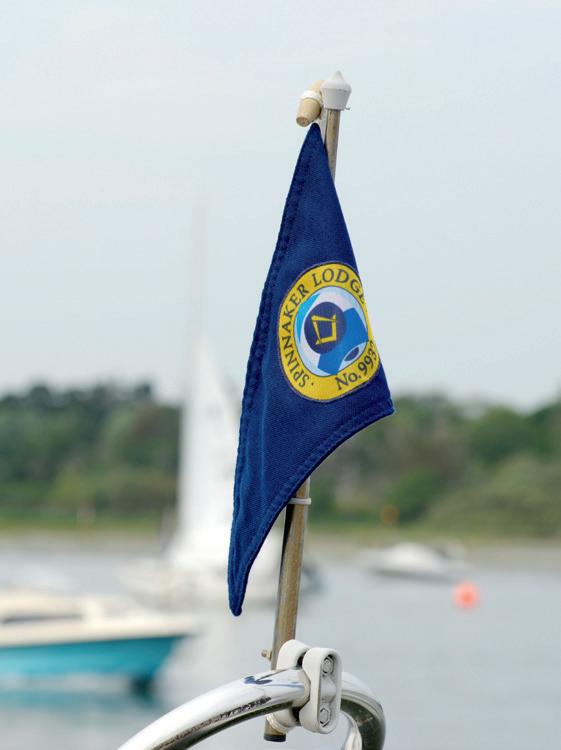
A pontoon party is usually held between the boats on Saturday afternoon, after which the members change into the Lodge dress code of blazer, chinos and deck shoes and make their way to the local Masonic centre for their Lodge meeting.
The meetings themselves continue the nautical theme, with the three gavels being substituted by a belaying pin, a deadeye and a serving mallet – all items retrieved from classic sailing yachts – and the Lodge burgee flying on the Senior Warden’s pedestal.
Afterwards, dining is less formal than at a normal Masonic meeting and regularly includes a short talk by a member or invited guest on a subject of nautical interest. In the past, these have featured a slideshow of a member’s sailing trip to Norway, personal experiences of the disastrous 1979 Fastnet Race
and presentations by local sailing charities that the Lodge supports.
The evening traditionally ends with a rendition of ‘What shall we do with a drunken sailor’ before retiring to the boats for a nightcap and an early sail home the following morning.

In the words of the Primus Master, Frank Milner, ‘It is important to us that the Lodge remains true to its purpose, develops its own traditions and points of difference and presents a contemporary and attractive image to the local sailing community.’
All of which are surely being achieved given that the Lodge continues to grow in strength and popularity.
Top: Leaving their boats, Spinnaker Lodge members in Lodge dress code make their way to one of their regular meetings at a nearby Masonic Centre

Bottom: The Spinnaker wives and girlfriends, or ‘SWAGS’ as they are affectionately known, have become firm friends







Interested in learning more about the Royal Arch? A new booklet clarifies the journey of becoming a Companion
The Discover More booklet, produced by Supreme Grand Chapter, is designed to introduce Master Masons and others to the Royal Arch. It has been created by a number of Royal Arch Companions and extensive work has gone into identifying the key messaging. It is also being shared with Provinces for distribution in order to maximise its use. So far, take up has been superb.
The new ‘Strategy for Freemasonry 2022 and Beyond’ makes it clear that we are one organisation and reinforces the indissoluble link between the Craft and the Royal Arch. When the Antient and Modern Grand Lodges came together to form the United Grand Lodge of England in 1813, they declared that ‘Pure Antient Masonry’ consists of three degrees - the Entered Apprentice, the Fellow Craft, and the Master Mason, including the Royal Arch.


This declaration still stands at the front of our Book of Constitutions and means there are four parts to a Freemason’s journey. For historical reasons, the fi rst three are governed by UGLE, while the Royal Arch is governed by the Supreme Grand Chapter of England. But in real terms, this represents one journey through one organisation.


Because of this link, our Grand Master automatically serves as the First Grand Principal in the Royal Arch, and many other senior roles are also shared. This connection makes English Freemasonry unique around the world and represents an important part of our history and heritage.
One Journey One Organisation
The Next Chapter
What will I discover? Answers


The new ‘Strategy for Freemasonry 2022 and Beyond’ makes it clear we are one organisation
If you would like to read the booklet, you can access it through the QR code here:

Masonic Lodges were arguably more visible in Scotland than England and Ireland during the 17th and early 18th centuries. Many Scottish Lodges can point to well-documented histories, with some 30 Lodges present in Edinburgh, Glasgow, Stirling, Dunfermline, Dundee, Aberdeen, Perth, Dunblane and Inverness.

The members of these Lodges were predominantly working Masons, part of the fabric of Scottish towns whose councils regulated such trades and issued charters of incorporation, known as ‘seals of cause’. The Incorporation of Wrights and Masons of Edinburgh, for example, received a seal of cause in October 1475. Known subsequently as Mary’s Chapel, it is one of Scotland’s earliest Lodges.
Nonetheless, although English documentation is less well ordered, the position was similar south of the border. We can see this clearly in the Old Charges, the earliest records of stonemasons’ Lodges, the first of which dates to the late 14th and early 15th centuries.
Formal regulation of the stonemasons’ trade and operative Lodges in Scotland began at the end of the 16th century when the King’s Master of Works, William Schaw of Sauchie, promulgated new statutes and regulations. Around a half century later, perhaps earlier, Scottish Lodges began to admit notaries to act as clerks and non-operative members of the local gentry and merchants to serve as patrons who would subsidise the expense of running the Lodge.
Virtually the same pattern is found in England, most obviously with Lodges in Chester, Warrington and York, and in earlier Lodges.
The 1707 Acts of Union which bound Scotland to England to create the United Kingdom of Great Britain brought about wholesale changes to Scotland and shifted the centre of power from Edinburgh to London. One effect was to advance the spread of ideas emanating from London, in particular the Enlightenment
In this Tercentenary year of the 1723 Constitutions, Dr Ric Berman explains how ‘Modern Freemasonry’ emerged in Scotland after the creation of the Grand Lodge of Scotland
principles and Newtonian science of the Royal Society.
There was also a tendency to emulate London society, especially among the mainly Protestant pro-Hanoverian landowners and aristocrats of the Lowlands and West Coast, many holding residences in both Edinburgh and London.
Iain McIntosh, a Scottish Masonic historian, has written that there is evidence within Scottish Lodge records that a more recognisable form of ‘Modern Freemasonry’ emerged after the 1715 Jacobite rising through to the creation of the Grand Lodge of Scotland in 1736. This form of ‘gentlemanly Freemasonry’ was designed to copy that which had become established in London.
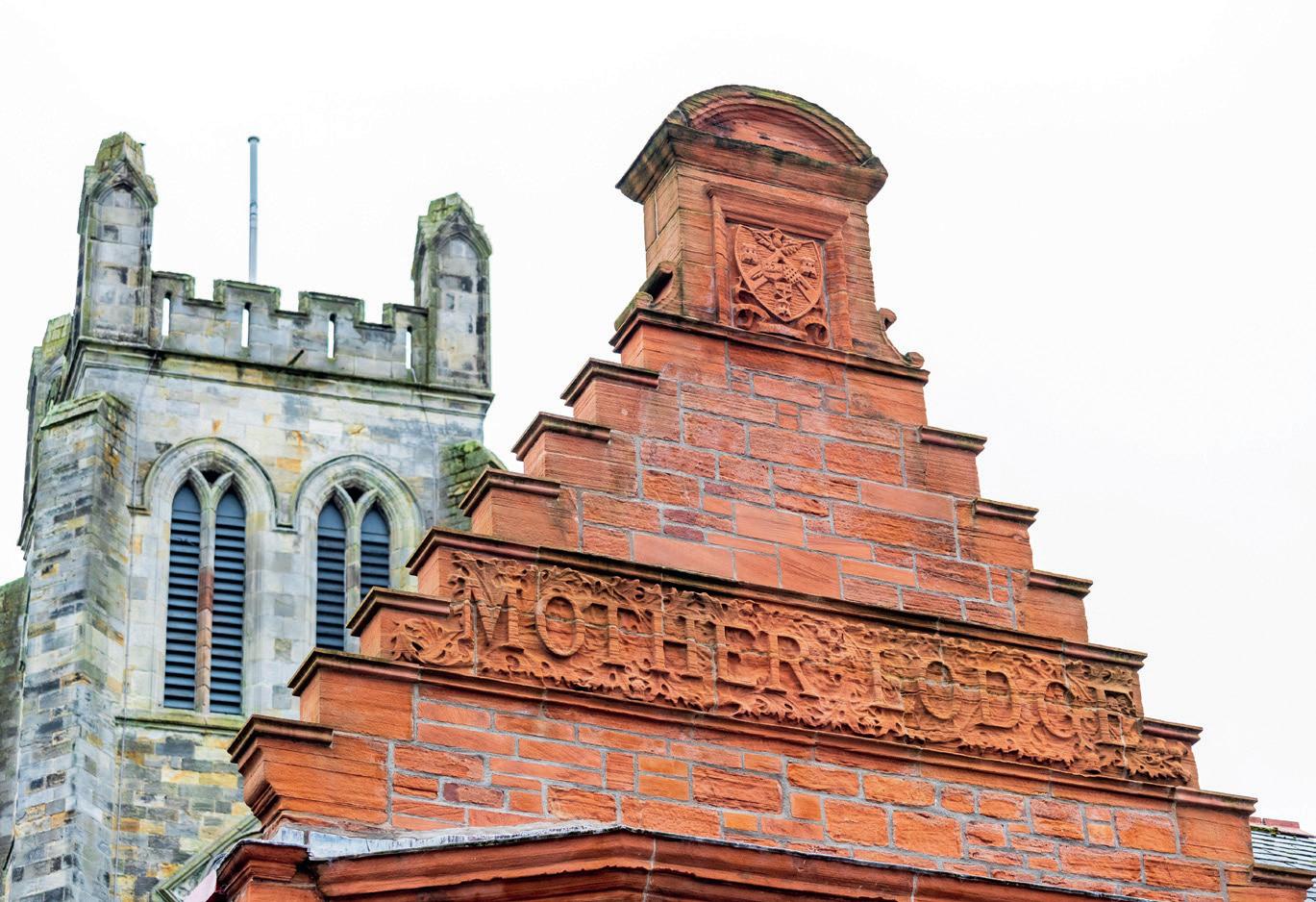
That Scotland did not form its own Grand Lodge until 1736, after England (1717) and Ireland (1725), highlights the relatively independent and mainly operative nature of Scottish Lodges. This is substantiated by the process by which the Grand Lodge of Scotland was formed.
The Grand Lodge of Scotland was initially a venture promoted by four fashionable Edinburgh-based Lodges whose members were predominantly gentlemen: the Lodge of Edinburgh No.1;
Canongate Kilwinning No.2; Leith Kilwinning; and Kilwinning Scots Arms. And although invitations to attend the inaugural meeting of the Grand Lodge of Scotland went out to 100 Scottish Lodges, only 33 chose to attend. The large majority of Scottish Lodges did not support an overarching Grand Lodge and preferred to remain independent.
Indeed, this only began to change when Lodges were assigned numbers to reflect their relative age, a process that started in 1737 based on ‘proofs’ – documents and artefacts that established their lineage and relative antiquity.
McIntosh comments that ‘following the publication of the Roll, there was a rush from the other Scottish Lodges to join, each producing documents, etc, of the age of the Lodge, and there resulted a jostle to prove an early foundation and claim a lower, more senior number’.
Scottish Lodges at this time recognised a two-degree system, the Apprentice and Fellow Craft, and the ‘Mason Word’ was the principal secret alluded. The first mention of a Third Degree, a degree that many believe was developed by Desaguliers, does not occur until 1726 when it is recorded in the minutes of Lodge Dumbarton Kilwinning.
And although it spread fairly quickly, it was not taken up universally. The degree was mentioned in 1728 in Lodge Greenock Kilwinning, in Lodge Kilwinning in 1735, Canongate Kilwinning in 1736, and in the Lodge of Edinburgh in 1738.
Although there was no formal relationship between the Grand Lodge of England and the Grand Lodge of Scotland, there were numerous personal connections between Scottish aristocrats and politicians and their counterparts in England. Many Scottish noblemen were Members of Parliament with properties in London. They were also part of London society and active in London clubs and societies, including the Royal Society with its association with Enlightenment and Newtonian science.
The strong Masonic connectivity is evidenced in the plethora of Scottish aristocrats who were Grand Masters of the Grand Lodge of England prior to 1750. They include Francis Scott, 5th Earl of Dalkeith, Grand Master of England in 1723, a Scottish representative peer and Fellow of the Royal Society (FRS).
Others followed: James Hamilton, 7th Earl of Abercorn, Grand Master of England in 1725 and FRS; James Lyon, 7th Earl of Strathmore, Grand Master of England 1733, also FRS; John Lindsay, 20th Earl of Crawford, Grand Master of England in 1734 and FRS; John Keith, 3rd Earl of Kintore, Grand Master of Scotland 1738-39 and Grand Master of England 1740; James Douglas, 14th Earl of Morton, Grand Master of Scotland 1739-40 and Grand Master of England 1741, FRS, later President; and Thomas Lyon, 8th Earl of Strathmore, Grand Master of Scotland 1740-41 and Grand Master of England 1744.
The relationship changed dramatically in the second half of the 18th century with the advent of Antient Freemasonry, which was later recognised by the Grand Lodge of Scotland.
Freemasonry is centered around the principles of charity and self-improvement, with a strong focus on benefitting ourselves and our communities. In line with this ethos, the United Grand Lodge of England (UGLE) participated in a new initiative called The Big Help Out. Launched nationwide on 8 May to help mark the Coronation of His Majesty the King, the campaign aims to uplift and enhance local communities. UGLE encouraged Freemasons to volunteer for The Big Help Out and we have collected stories from Freemasons across the country who generously contributed their time and energy. These stories shine a light on just a few of those fantastic efforts.
During The Big Help Out, Oxfordshire Freemasons joined forces with local hospitals to bring smiles to the faces of young patients. In a heartwarming display of generosity and compassion, they distributed between 400 and 500 teddy bears to children at hospitals in Oxford, Horton, Abingdon, Henley and Witney. Under the expert guidance of Oxfordshire Freemason Roger Hampshire, the Province’s Teddies for Loving Care programme provides comfort to children during their hospital stays.
Devon
Freemasons in Devon got their hands dirty and organised a Clean for the King

initiative. Okehampton Freemasons teamed up with local community organisation the Okement Rivers Improvement Group (ORIG) to tidy up litter around the town.
Using Okehampton’s Lodge and Chapter of Obedience as a meeting point and base for refreshments, they were joined by parents and children from the local primary school, members of the local Lions Club, town councillors and members of other community interest groups.
The Okement Rivers Group handed out prizes for categories such as the biggest piece of rubbish collected – an abandoned ‘road closed’ sign. The most unusual piece of rubbish was hotly contested, but was won by a decorative false fingernail.
Local Freemason Chris Hodgson said, ‘It was a fantastic community get-together with great teamwork and companionship, and a great demonstration of what a community can do.’
Freemasons in Cheshire showcased their green-fingered skills when they got involved in activities to help maintain a tranquil green space in Runcorn.

The Green was previously a pub football pitch and a potato field, and was turned into a serene oasis in 2000. It serves as a recreational space and a venue for village events. In commemoration of the Coronation, volunteers planted heritage trees, including a cherry and rowan
tree for The Queen’s Green Canopy. The volunteers not only focused on tree planting, but also dedicated their efforts to the upkeep of raised plant beds. These serve as educational spaces for local schoolchildren and scouts to learn about gardening and horticulture. Simon Medland, a Freemason and volunteer, expressed his delight, describing the experience as a ‘brilliant day’.
Essex
Essex Freemason David Barton organised a craft stall as part of a competition for children to get creative and celebrate the Coronation.
Founder of the charity Get Started Art, David brought together Freemasons from
Kids get crafty in Essex, making royal crowns for ‘The King and the Craft’ competition. Devon Freemasons, meanwhile, work with the local community on a big town clean-up campaign
across Essex to work with the community and create a memorable event in the Essex town of Grays.
The ‘King and the Craft’ competition was devised for children across the borough to design and create a royal crown in honour of the King. Almost 200 crowns were made on the day at Grays Town Park and prizes were supplied by local Masonic Centres.





UGLE would like to thank all members who volunteered their time and got involved in The Big Help Out.

We’re happy to share that the Grand Master HRH The Duke of Kent has made the following Provincial appointments.
Nicholas Ball was installed as Provincial Grand Master for Devonshire on 17 April, succeeding Ian Kingsbury who retired on 4 March.
Ian Copestake was installed as Provincial Grand Master for Derbyshire on 1 April, succeeding Steven Varley on the latter becoming Assistant Grand Master on 8 March.
David Allan will be installed as Pro Provincial Grand Master for and Grand Superintendent in and over Middlesex on 2 October,
succeeding Peter Baker who will retire on 1 October.
Jolyon Berry will be installed as Provincial Grand Master for and Grand Superintendent in and over Suffolk on a date to be arranged. He will succeed lan Yeldham who will retire at the beginning of October.
And in his capacity as First Grand Principal, The Grand Master appointed E Comp Anthony Howlett-Bolton as Grand Superintendent in and over Berkshire on 24 July, succeeding E Comp Ian Hopgood who retired on 1 May.
Anna Baker Cresswell, the founder and executive director of the charity HighGround, hosted the Provincial Grand Master for Bedfordshire Tony Henderson along with Steve Attwood and David Hargreaves at the Defence Medical Rehabilitation Centre (DMRC), Stanford Hall on 6 July when they visited to present her with a cheque.
HighGround helps service leavers, reservists and veterans work out how their military skills and experience might complement work in the land-based sector, and how they can access employment and self-employment opportunities in the UK and overseas.
Bedfordshire Freemasons collected £2,350, which will fund one serviceman to undergo a rehab programme in the specially adapted garden that
HighGround has built through donations to the DMRC. The money will also help towards buying more equipment and further development of the garden.
During the event, Group Captain Chris Rowley, commanding officer of DMRC Stanford Hall, graciously invited everyone to Beating Retreat, a special occasion where the guest of honour was Air Marshal CS Walton who was four days into her new job as director general Defence Medical Services. The weather was perfect for the Red Devils’ display and the Band of the Brigade of Gurkhas topped the Sunset Ceremony. All in all an unforgettable day.
This donation reinforces Bedfordshire Freemasons’ commitment to the Armed Forces Covenant to assist injured serving personnel and veterans in fi nding enjoyable careers after leaving the forces.

As part of their Aprons Off campaign to showcase life beyond the Lodge, Buckinghamshire Freemasons have told the stories of 33 of their members. ‘We wanted to illustrate the wonderful things we do outside of Freemasonry and the diversity of our experiences to make us more approachable to non-Freemasons,’ said communications team member and project lead David Clark.
One featured Freemason is Marc Lonergan who joined Freemasonry in 2013 and is a member of Planet Lodge No. 8142. Marc is an offshore and inshore yacht racer. He started sailing in 2009 after reading about the sport and buying his own 28-ft boat The Eclipse. He has won numerous races, titles and awards and is looking to take on the significant challenge of a solo around the world race in 2026.
Like many others, Marc believes the meeting of the Lodge is the best part of Freemasonry. He puts his enjoyment down to the ‘learning and brotherhood’ aspects and says that Freemasonry has helped keep him more grounded and focused. Being part of Freemasonry, Marc has not only improved his mental skills but also his communication skills around others.
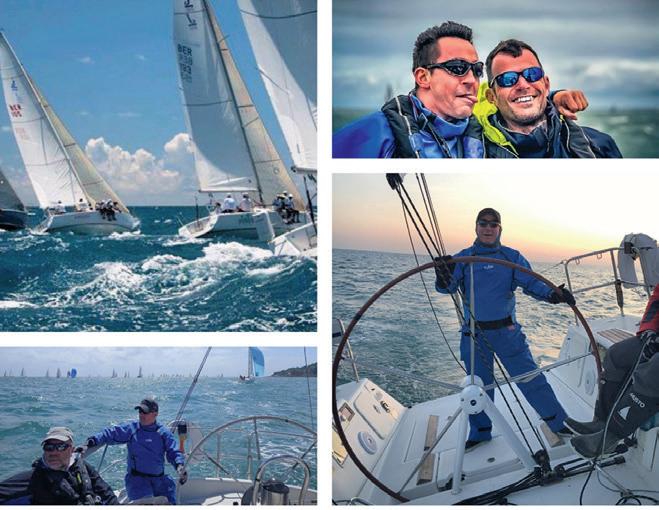
Representatives of several University of Cambridge college Lodges, along with the Oxford & Cambridge University Lodge (O&C), Isaac Newton University Lodge (INUL) & Granta Lodge (Order of Women
Freemasons – OWF) met at Bateman Street, Cambridge to discuss improving ties between university and college Lodges. They debated ways to support University of Cambridge students interested in Freemasonry, how to help the OWF in establishing a women’s Lodge for students at Cambridge, and the establishment of a Cambridge University society dedicated to Freemasonry.
The meeting followed a successful freshers’ fair where representatives from both United Grand Lodge of England (UGLE) and the Order of Women Freemasons chatted to newly arrived students. Around 40 students signed up for more information, including 14 for OWF.
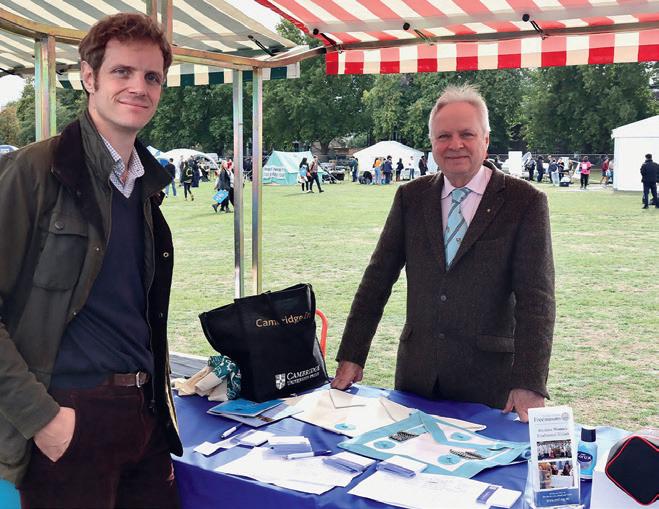
Establishing ties with other college Lodges and the Province of Cambridgeshire will help members find a Masonic home after their graduation, in line with the UGLE Universities Scheme. Omaid Hiwaizi (O&C University Lodge), Simon Cooper (INUL), Peter Featherman (Lodge of Trinity) and Karen Ottewell (Granta) met at Cambridge Masonic Hall. The UGLE members then attended an INUL meeting, dining at Queens’ College along with Jonathan Price (Caius Lodge) and the Provincial Grand Membership Officer Ed Williams.
Ed explained, ‘Promoting closer ties between all of our Lodges in the Province of Cambridgeshire is of vital importance to attract new members and to look after our existing ones. To extend our ties further to the wider college Lodges will see the Province of Cambridgeshire continue to thrive. We look forward to cementing these bonds and developing meaningful relationships.’
The Crich Tower memorial in Derbyshire is dedicated to the 11,409 Sherwood Foresters who died in World War I, as well as the 1,520 casualties in World War II. It also commemorates those who gave their lives for their country between 1945 and 1970 and the Worcestershire and Sherwood Foresters who were lost between 1970 and 2007, and those of the Mercian Regiment since 2007.
An annual service is held there, when members of the Mercian regiment, old and new, gather to pay their respects. Derbyshire Freemasons were invited to attend and were honoured to do so.
Following a meeting between the then Provincial Grand Charity Steward of Derbyshire Freemasons Michael Hitchcock and Cindy Clarke (assistant regimental secretary of the Mercian Regiment), it became clear that Freemasons might be able to assist in bringing something new to Crich. The Freemasons of Derbyshire had already given assistance to the air cadets and sea cadets as well as having many members who are ex-military, so supporting the Crich Memorial was a natural step.
The regiment was hoping to create a memorial garden on the site, and local Freemasons pulled together to get the work done. The result is a stunning garden area for reflection and remembrance.
The garden was opened on 19 June, when the Provincial Grand Master for Derbyshire Ian Copestake was joined by the Lord Lieutenant of Derbyshire, Elizabeth Fothergill, the High Sheriff of Derbyshire, Theresa Peltier, The Mayor and Mayoress of Amber Valley Cllr Tony Holmes and Mrs Lindsay Cox, and members of the Mercian Regiment including the mascot Lance Corporal Derby. Joining them was Assistant Grand Master of the United Grand Lodge of England Steven Varley.

Devonshire Freemasons in association with the Masonic Charitable Foundation (MCF, the Freemasons’ charity) presented Devon’s Stop Abuse For Everyone (SAFE) Foundation with a donation of £60,000. This will be paid over three years and will provide guaranteed income for a charity that aims to break the cycle of abuse.

SAFE Foundation has a bold vision. It is one of the leading domestic abuse recovery organisations in Devon and beyond. It exists to tackle the impact of childhood trauma that affects more than 8.4 million people in the UK alone. In Devon, around 1,600 individuals and 170 families were assisted last year.
Lucy Sky, programme development lead and therapist at SAFE said of their Flourishing Futures programme, ‘FF will support young people aged eight to 18 who have experienced trauma, domestic violence and abuse (DVA), to lead healthy and fulfilling lives. Experiencing DVA is a key predictor for serious youth violence [Home Office 2019]. We know that experiencing DVA as a child or young person can set up the trajectory into offending behaviour or victimisation in later life – we want to reduce the risk of exploitation and violence.
‘Flourishing Futures will lead to emotional and practical change, including an increase in feeling safe, expressing emotions healthily, reduction in agency support and decrease in risky or offending behaviours. Working in partnership with schools, education staff will expand their knowledge of supporting young people and can share this learning across the school community.
‘Our evidence gathered so far shows that support stimulates long-term healing and recovery, strengthening families by promoting autonomy, growing trust and stability, redefining a young person’s experience of healthy relationships.’
In May, Deputy Grand Master Sir David Hugh Wootton and Deputy Grand Director of Ceremonies Paul Grier visited Namibia.

The reason for the visit was to conduct the installation of the incoming District Grand Master for the English Constitution in Namibia Gernot Piepmeyer, as the previous District Grand Master Alan Simmonds’ term of office had ended. The installation weekend was attended by Freemasons from all corners of Namibia, as well as visitors from the English Constitution from Zambia, the Northern Cape, Western Cape and Central Divisions of South Africa. Also in attendance were representatives from the Provincial Grand Lodge of South Africa and a delegation headed by the District Grand Master of the Scottish Constitution in Namibia.
Members enjoyed a Friday night Braai followed by a meeting with the DistGM and visiting DepGM, the installation and a banquet on Saturday, during which the UGLE delegation presented a donation from the Grand Lodge of England to Multiple Sclerosis Namibia for N$100,000, and had a Sunday lunch before departing.
There are three Constitutions and their Lodges who meet across Namibia – the English, Scottish and South African.
The first Freemasons Lodge opened in Swakopmund in 1908 and conducted its meetings in German. Later, a Lodge opened in Lüderitz and then in Windhoek, falling under the Grand Lodge of Hamburg. After World War I, the English and Scottish Constitutions opened Lodges. The South African involvement led to the opening of a South African Constitution Lodge in Grootfontein.
There are 10 Lodges in Namibia. Damaraland Lodge No. 4758 was consecrated in 1926, and is looking forward to celebrating 100 years of English Freemasonry in Namibia in 2026.

Michael Graham Donne, a member of Flambard Lodge No. 6874, and his wife Ruth have been awarded Durham County Council’s Chairman’s Medal. This award is the highest civic honour the county council can bestow and was awarded for ‘outstanding voluntary services to the community’. The presentation took place at County Hall in Durham, by the Chair of Durham County Council, Councillor Joan Nicholson.
Councillor Nicholson’s citation read, ‘We are here today to honour the hard work and devotion of Ruth and Mike. They have both dedicated their lives to supporting the armed forces community. Ruth and Mike, you have become a vital lifeline of hope and support for so many, especially those going through challenging circumstances. From pandemics and lockdowns to the cost-ofliving crisis, you have offered unwavering support. You ensure that the voices of our most vulnerable are heard and their needs are met. Through your work with the armed forces charity SSAFA, you have helped countless people get back on their feet and regain their self-esteem. You have created a support network that has been described as lifesaving – especially during lockdown. I was moved to hear how you both, along with other volunteers, made sure that those facing isolation and social exclusion felt seen and supported. Your extraordinary efforts serve as an inspiration to us all.’
In July, East Lancashire Freemasons Doug Smith and Russell Perks attended St Paul’s Church Hall in Norden, Rochdale, to deliver a presentation about Freemasonry to 30 members of Norden’s Women’s Institute called ‘Do you want to know a secret?’
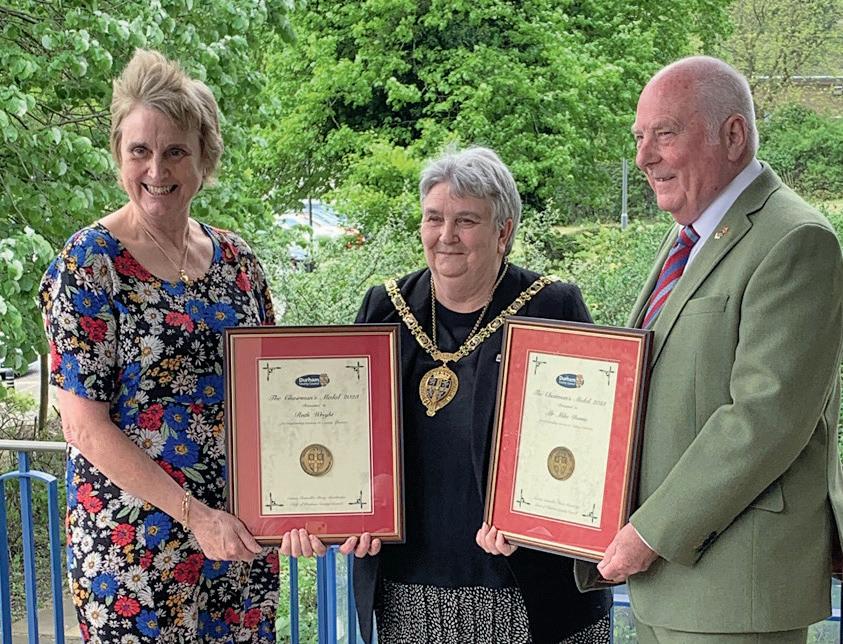
During the presentation, Doug highlighted the traits that both the Women’s Institute and Freemasonry have in common and dispelled the myths, misinformation and conspiracy theories that circulate about Freemasonry.
He explained that Freemasonry is committed to universal brotherhood and self-improvement, enabling you to develop social skills. He also stressed that becoming a member inspires a desire to support and bring happiness and helps forge lifelong friendships.
Doug described the charity work that Freemasons do for both Masonic and non-Masonic charities and how Freemasons have donated to local and national charities and international relief funds for natural disasters worldwide. He also explained that charity can mean donating money or giving your time for volunteering work.
He broadly explained what happens in the Festive Board and the Lodge room. Both are an essential part of any Masonic meeting, allowing members to enjoy the social side of Freemasonry and the more formal ritual.
The presentation was brought to an end with a Q&A session, refreshments and a display of Masonic regalia.

Isle of Wight Freemasons presented cheques to representatives of their local charities at an event attended by dignitaries, including the Lord Lieutenant, High Sheriff and the Vice Chair of the Isle of Wight Council. Held at the Cowes Masonic Hall, the presentation also allowed the charities to speak about the work they do.


Isle of Wight Freemasons donated more than £62,000 to Island charities in 2022.
Charities that benefitted included: Ryde Sea Cadets, Mountbatten Hospice, Sandown and Shanklin lifeboat, Vectis Brass Band, IoW Defibrillators, IoW Community Heart Failure Unit, Men Only Ryde, and Home-Start IoW.
Adrian Cleightonhills, who heads up the Solent Area for the Hampshire & Isle of Wight Freemasons, outlined the role Freemasonry plays in supporting good causes. He said, ‘Freemasons are very much part of the island’s close-knit community to which they make such an important contribution. I’m very proud of our members and Lodges who have been able to help so many of our local charities.’
Mrs Dawn Haig-Thomas, the High Sheriff of the Isle of Wight, speaking to those attending the event, said, ‘I have learned so much about the work you do and the generosity of the Island Freemasons. This event has worked so well having all recipients explain who they are and what they do.’
Eastor Lodge members decided to set themselves the challenge of hiking up Ben Nevis, Scafell Pike and Snowdon over three days in June to raise money for local charities.
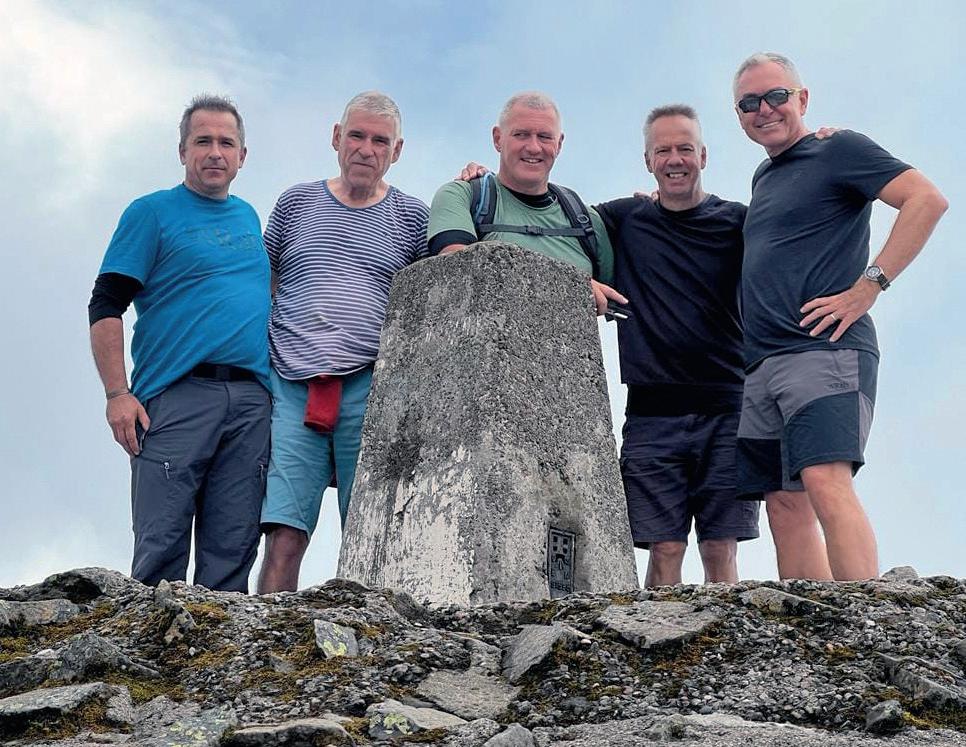
The group is hoping to raise funds through both their JustGiving page and
the Herefordshire Masonic Charity Association for two charities: the Ledbury Food Bank, which helps families in hardship, and for We are Farming Minds who help to break the stigma surrounding mental health in the farming community.
As Freemasons, caring and supporting the local community is central to their purpose and as many in the current climate are in need of support, they would like to do their part.
11. ISLE OF MAN
In April, members gathered alongside 30 charity representatives for an evening of presentations and fish and chips for what was the first charities forum organised by the island’s Freemasons. Head of the Isle of Man Freemasons, Provincial Grand Master Martin Blackburn, opened the event by giving a detailed overview on how the Masonic charities work and he explained the independent charity efforts of the 19 Masonic Lodges on the island.
A total of 10 charities that receive assistance from the Isle of Man Freemasons were represented – including Crossroads Care, the TT Riders Association and Friends of the TT Riders Association, the Isle of Man Anti Cancer Association, Douglas Coal Fund, St John Ambulance, Live at Home, the Manx Benevolent Fund, the Motor Neurone Disease Association Isle of Man and Southern Befrienders.
The charity representatives explained the work they do, and how they feel Freemasonry can best support them through these difficult times. The help and assistance provided to all walks of life by all those volunteers is extraordinary and often completely under the radar.
After an evening meal, a raffle was held. A donation of £250 had been received to be given to one of the represented charities. All being well, this sum will be match funded, so the charity could receive a total of £500. The name of each charity was put into a box and a draw was made. The lucky winner was Live at Home. Not only did they win the £250, but Steve Hall, the Immediate Past Master of St Maughold Lodge, and his wife Tina also presented a cheque for more £1,500 that had been raised at their Ladies Night.
Besides financial help, Freemasons were able to offer help in the form of volunteers and free use of meeting rooms for charities. A group of Freemasons also offered the use of a minibus and, if needed, the members will offer their services as chauffeurs.
Achieving his £100,000 fundraising goal for the Masonic Charitable Foundation (MCF, the Freemasons’ charity) could make round-Britain walker Chris Jones a record-breaker. It’s believed that no one has contributed such a sum to Masonic charity through their individual efforts.
He was supported by Neil Boyes, Provincial Grand Charity Steward of the Mark Degree. Craft, Mark Degree and the other companion degrees all give to charities. The Mark Charity donated its second fully equipped ambulance to St John Ambulance on the island. Many Freemasons, including ambulance driver Martin Blackburn, give up their spare time to assist the charities.
That’s the prediction of the MCF’s Chief Executive Les Hutchinson, made when the two met face-to-face for the first time at Lincolnshire’s Provincial Grand Lodge meeting, though he agreed it would need to be confirmed.
It was a combination of circumstances which brought Chris and Les together at the Epic Centre at the Lincolnshire Showground. Chris was taking a break from his 7,500-plus mile solo walk to

return for the Provincial Grand Lodge meeting and to install Andy Bagworth as his successor as Master of the Free Wheelers Lodge No. 9991. Les had been invited months before as guest of honour.
Chris came a step closer to achieving his fundraising goal when Provincial Grand Master Dave Wheeler called him out from the ranks of the Lodge Masters to give him a donation of £10,000, more than doubling the money already pledged on his fundraising page. Chris paraded round the room to the Proclaimers’ hit I’m Gonna Be (500 Miles), played by Provincial Organist David Shepherd.
Before he set out on the walk, Chris had worked with Provincial Communications Officer Stuart Pearcey to set up the fundraising page, one of the first using a new MCF fundraising platform. Chris said, ‘We talked about what target we should set, and we mentioned £25,000 and £50,000, but in the end I decided I should shoot for the moon and set it at £100,000.
‘With the wonderful and unexpected donation from the Province of Lincolnshire, the £9,000-plus pledged already, Gift Aid yet to be added, and lots of Provinces yet to visit, the total has become very much more realistic.’
Chris embarked on his walk on New Year’s Day in Skegness, determined to circumnavigate the country to raise awareness of mental health issues, and to raise funds to help sustain the MCF’s work, which includes a mental health service he credits with saving his own life when he was close to suicide. Chris is chronicling his journey in an entertaining blog, with regular updates and a dedicated following of regular readers. His posts reveal how well he has been supported by Freemasons, who have given cash donations as well as inviting him to their meetings, offering accommodation, and walking alongside him.
There was a wonderful evening of Masonic entertainment recently at the Borough Theatre Abergavenny, as Keith Davies reprised his ‘Abergavenny Elvis’ to raise money for local charities and celebrate all that is good about Freemasonry.

Keith Davies is currently the Worshipful Master of St John’s Lodge No. 818 in Abergavenny, having been installed in the Chair of King Solomon in February 2023. Along with his Masonic duties, Keith has another passion: impersonating the great Elvis Presley. This passion for performing as the King of Rock and Roll goes back more than 20 years. Over that time, Keith has raised over £400,000 at events in the UK and over €6,500 at overseas’ concerts – all donated to local charities. Keith is ably supported by his band The Memphis Mafia, and together they perform purely for charity with no expenses taken.
In recognition of his charitable work, Keith was awarded the British Citizen Award for Volunteering and Charitable Giving (BCAV), presented to him by the now King Charles III, who was then the Prince of Wales.
This award is presented to an individual who has contributed extensively to fundraising, charitable giving or devoted time and energy voluntarily to a selection of charities in a prolonged approach. The concert was well attended by Monmouthshire Freemasons, their families and friends. In the audience were many members of the Provincial Team who were keen to lend their support to the event. The Deputy Provincial Grand Master Chris Evans was also in attendance. The night had a unique twist as Elvis was joined on stage by Chris who belted out the Elvis favourite If I Can Dream, to rapturous applause from the audience.
Chris said, ‘Freemasonry is about building lifelong friendships and raising
money for charity. Nights such as this promote a positive image of Freemasonry, and it also gives an opportunity for Freemasons and their families to come together to raise money for good causes. Keith has a great voice and is a credit to Freemasonry. It was kind of him to invite me to accompany him on stage, and I was very happy to join in support of charity, but I don’t think I’ll be giving up the day job.’
Elvis left the building after raising a considerable amount for charitable causes. He’ll be seen at the same venue in December 2023.
Earlier this year, a group of Monmouthshire Freemasons, led by Kelvin Reddicliffe of Armed Forces Lodge No. 9875, dreamed of creating something extraordinary to celebrate the 10th anniversary of its consecration in 2013. The Armed Forces Lodge meets at Newport Masonic Hall, and its membership is traditionally made up of those who have served in the military. They embarked on a unique mission: to produce a special CD as a tribute to the brave men and women who served in the World War I, for which they have deep admiration and gratitude.
Kelvin and the team produced a CD called Amor Patriae (love of one’s country), a collection of songs and poems that uplift, inspire and resonate with the listeners. Kelvin reached out to Freemasons across the Province. He wanted to ensure that the music they produced truly encapsulated the experiences and emotions of those serving in the armed forces while promoting the values that Freemasons of the Armed Forces Lodge hold dear.
The response from the Freemasonry community was overwhelming. For months, the production team immersed


themselves in the project. They crafted a selection of songs and poems, weaving together elements of rock, folk and orchestral arrangements to create an incredibly powerful and moving musical experience. The music was composed and arranged by Kelvin and performed by the Carl Simmonds Ensemble.
The CD was recorded and pressed locally at Pinewood Audio Recording Studios in Pontypool, and the dream became a reality. The limited run of CDs found its way into countless homes, serving as a poignant reminder of the bond between those who protect and those who are protected.
Through their CD, the group created a tangible connection between the brave men and women in uniform and the communities they safeguard. Kelvin said, ‘I would like to thank all the team that helped with the project, including a special call-out to WBro David Llewellyn, who helped with the poetry. The CD became a labour of love and reflects the immense sacrifice of those who fought in the Great War.
‘It is a fitting way to celebrate the 10th anniversary of the Armed Forces Lodge 9875, whose members have themselves served.’
Another CD is already in production to celebrate the Province of Monmouthshire’s 2024 Festival Appeal. It will once again showcase the artistic talents of members across the Province. Well done to all involved.
St Cyngar Lodge No. 5323 has donated £3,250 to Guide Dogs Cymru and has had the honour of naming a puppy Mason. Members hosted a fundraiser in support of the charity, raising more than £1,300. The evening was attended by over 50 guests. WM Royston Slater-Mason presented a cheque to Guide Dogs Cymru on behalf of members, supported by the North Wales Freemasons Charity (NWFC).
Rob Armstrong, group coordinator and treasurer for Guide Dogs Gwynedd said, ‘We’d like to thank St Cyngar Lodge for their generous donation to Guide Dogs Cymru. Donations like this have supported some amazing guide dog partnerships in Gwynedd, and this support will help the charity to train even more life-changing dogs.’
On a sunny day in June, a group of Somerset Freemasons partnered with the Somerset Duke of Edinburgh Award (DofE) on their inaugural bike ride. Joined by DofE participants from Haygrove School and King’s College, they took on a 30-mile cycle ride along the Bridgwater and Taunton canal.

Two members of On Your Bike also joined the group to ensure help was at hand for any mechanical issues. On Your Bike is a charity that has benefited previously from Masonic fundraising and they were more than happy to get involved.
The group started at King’s College Taunton, then cycled along the canal to Bridgwater Masonic Lodge where the students met with participants from Haygrove School. All parties enjoyed refreshments and a tour of the Lodge, taking in the fascinating history and Temple Room with a brief overview from Richard Winter. Haygrove students set off on the return route back along the canal to the Taunton Masonic Lodge where another round of refreshments and a quick tour wrapped up an amazing day. More rides are planned and those involved in this first ride have asked to make this an annual event, which just goes to show how much everyone involved enjoyed the day.
A £4,000 donation has been presented to the Sandra Chapman Cancer Centre and Ward 17 at the James Paget Hospital, raised by members of Lowestoft-based Orient Lodge No. 4085 after a 40-mile kayak challenge.
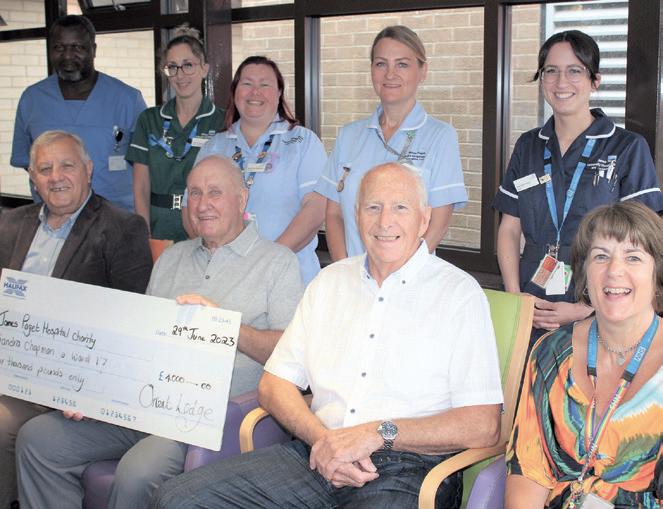
Ian Moir, Chaplain of Orient Lodge, supported by members of the Lowestoft Volunteer Lifeguard Corps and the Orient Lodge support team, undertook the
40-mile kayak paddle around Lowestoft, Gorleston and Burgh Castle in August 2022 to raise money for the centre.
Starting at the Lifeguards Lowestoft beach headquarters, they headed up the coast to the mouth of the River Yare between Gorleston and Great Yarmouth, before following the river inland to Burgh Castle and then taking the River Waveney via St Olaves and back through Oulton Broad to Lowestoft. The route was designed to circle the James Paget Hospital via the waterways that encircle the hospital. They completed the kayak paddle over the course of two days.
Through sponsorship from local Lodges and fundraising, the team managed to raise a total of £4,000 to purchase two special treatment chairs. On 29 June, members of the Lodge visited the James Paget centre to formally hand over the donation to staff at the Sandra Chapman Centre and Maxine Taylor, the hospital charity manager.
John Holland, one of the Lodge members who was in the support team, said the fundraising had been a real team effort to raise money in memory of his wife Josie, who received treatment at the Centre and Ward 17 and who has since sadly passed away. The Centre is treating many of the area’s Lodge members and families as well as the general public who suffer from this terrible disease.
Maxine said, ‘We’d like to thank everyone involved in the kayak paddle and those who supported the fundraising. This generous donation will purchase two more of the specialist chairs which provide additional comfort for patients receiving treatment for cancer. This will directly benefit those using the Centre and the Ward and we’re grateful for your support.’

Freemasons John J Spence and Mark D Williams from Bishop Edward Story Lodge No. 8256 in Chichester decided to visit the remotest Lodge in the world as part of a fundraising initiative for the MCF Sussex 2028 Festival.
A quick glance through the latest issue of FMT under the ‘Across the globe’ section revealed that St Helena Lodge No. 488 met in the island’s capital of Jamestown. After seeking the necessary clearance from United Grand Lodge, they made contact with the Lodge Secretary and made plans to visit their March meeting.
Travel to the island is not simple. The first part was an 11-hour flight from Heathrow to Johannesburg and, after a 23-hour layover, they took the weekly 6.5-hour flight out to the island, involving a 30-minute refuelling stop in Walvis Bay, Namibia.
On Tuesday 14 March, they attended a regular meeting of the island’s only Lodge, which meets at Freemasons’ Hall, Napolean Street, Jamestown. They witnessed a ceremony of Passing followed by a local Festive Board. On Friday 17 March, they were invited to a dinner to meet wives and partners and once again were treated to some superb St Helenian hospitality.
During the regular meeting, they presented the Worshipful Master with a bound volume of letters and ‘pen pictures’ from those Lodges across the Province of Sussex who had supported the venture. Thanks to the generosity of Sussex Lodges, a grand total of £2,500 was raised for the Sussex 2028 Festival supporting the Masonic Charitable Foundation.

West Kent Freemason Bipin Patel has raised more than £3,000 for the West Kent 2026 Festival and the Masonic Charitable Foundation (MCF, the Freemasons’ charity) with a 72-hole golf challenge.

‘The thought of playing 72 holes had never crossed my mind and under normal circumstances this is not something I would consider,’ said Bipin. ‘At our first Provincial golf event I met Paul McGuirk, who looks after the golf in East Kent. He sent me details of the challenge. I did think at the time that it would be a tall order but the benefit of doing it and being able to raise money for our 2026 Festival prompted me to sign up for the challenge, hoping that I might have been able to persuade others to join me to make up a four-ball. Unfortunately, this wasn’t possible and I joined with Paul and two other members from East Kent to make up a four-ball.’
Leading up to the day of the challenge, they had to look for a new venue as East Sussex National Golf Club cancelled the event. Fortunately, Bipin’s home club Shirley Park Golf Club agreed to accommodate them. The actual day, 21 June, went well. The day started at 3am, and they were prepared to tee off by 4am. They completed 36 holes by 12.15pm when they had lunch, then started the second half of the challenge at 1.15pm. They completed the 72nd hole at 8.45pm.
‘Coming down 18th fairway for the fourth and last time was very satisfying,’ says Bipin. ‘I was absolutely delighted and thrilled to see our Provincial Grand Master accompanied with our Deputy Grand Superintendent and Assistant Provincial Grand Masters, Andrew Waddington and David Huntley waiting for me as we finished. Thank you for giving up your time. For the record, I scored 78, 86, 92 and 88 with 27 par and 3 birdies. Definitely room for improvement!’
Louis Spencer became a member of Aughton Lodge No. 7996 in 2022. He is married to Jade and has two children, aged four and one. He holds a senior position in the family warehousing and distribution business. Over 12 months in, Lewis reflects on his experience.
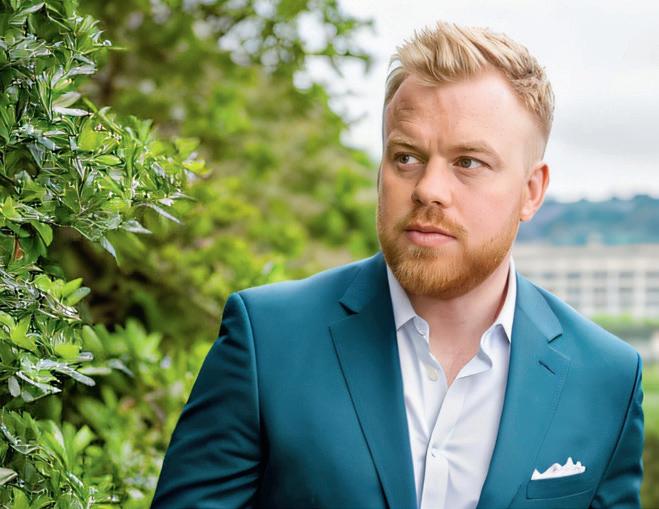
‘After years of researching and uncovering the mysteries surrounding Freemasonry, I made a life-changing decision – I became a Freemason. The realisation that some people I knew were already part of this ancient fraternity ignited a spark of curiosity within me, propelling me further down the path of discovery.
‘Joining the Freemasons has brought an immeasurable amount of joy and a profound sense of belonging to my life. The connections I’ve forged with my fellow Freemasons have surpassed any friendships I’ve encountered in my daily routine. These relationships go beyond mere acquaintances – they are a network of kindred spirits who uplift and support one another, creating bonds that transcend the ordinary.
‘But Freemasonry is more than just friendship – it’s an avenue for personal growth and development. The principles and values upheld by the organisation have guided me on a path of self-improvement and ethical living.
The rituals, teachings and symbols within Freemasonry have provided me with a framework for introspection and a deeper understanding of life’s profound questions.
‘If anyone has been yearning for something more – a sense of belonging, personal growth, and a community of like-minded individuals – I encourage them to explore the beautiful mysteries of Freemasonry. Who knows, it might just be the missing piece they’ve been searching for.’

We are all familiar with the phrase ‘four seasons in one day’, but how many Provincial Grand Masters have delivered all four Craft ceremonies in one meeting?

The Provincial Grand Master for Worcestershire Stephen J Wyer did just this. He successfully completed these in great style and to the delight of a packed audience who gathered to see this unique spectacle. A stunning 14-hour meeting saw the ceremonies of initiation, passing and raising performed. This was topped off by an installation ceremony into the Chair of King Solomon. This marathon event turned into an exemplary example of Worcestershire Freemasonry at its best.
The meeting held at Freemasons’ Hall, Kings Heath, Birmingham began with the passing of Brett Lavin. This was followed by the initiation of Benjamin AllsopTimmins. A break for lunch was followed by the raising of Kyle Toolan. Finally, and perhaps the highlight of the day, was the installation of Paul Walker into the Chair of Dofra Lodge No. 5775. The rarity of the occasion made it a day to remember, and offered a reflection point on the wonders of Freemasonry in its many forms.
This was not just a display of excellence but was also the ideal fundraising vehicle for the Festival 2022. Unbeknown to the gathered Worcestershire members in attendance, they reached the fundraising target as a result of £7,000 raised on the day.
In addition, at the third rising, more cheques were presented, totalling more than £15,000 for the Festival Appeal and pushing the Province well beyond its target. The cheques were from the Lodge of Progress No. 9893, Worcestershire
Masonic Motoring Club, Aedificandum Lodge No. 9937, and the Worcestershire Chapter of the Widows Sons. Some £10,000 alone had come from the work by the Worcestershire Masonic Lottery.
Malcolm Tonkiss of Captain Cook Lodge recently returned from the expedition of a lifetime to Fiji and Australia, representing the Lodge and Province at the centenary celebrations of Old Melburnians’ Lodge No. 317.

‘Reading that the Old Melburnians’ Lodge in Australia were planning their centenary celebrations for 18 February 2023, I decided that as WM of the Captain Cook Lodge No. 4636, I would go there to represent my Lodge,’ says Malcolm. ‘The Captain Cook Lodge has had a long association with the Old Melburnians’, dating back more than 70 years. Our Lodge history states that in 1951, WBro Dickie of the Captain Cook Lodge travelled to Australia and there met and formed a friendship with WBro Hartridge of the Old Melburnians’. This culminated in the exchange of Founders Jewels which since then have always been worn by the Master of each Lodge. These jewels are still presented and worn by the respective WMs in their year of office.’
He also planned a stop off in Fiji. ‘Having decided to travel this far I thought that it would be an opportunity to renew the Captain Cook Lodge’s ties with the Lodges of Fiji. These date back to 1969 and the Duke of Kent’s visit to the islands.’
His walk through history saw him attend multiple Lodge meetings where he got a warm welcome from Freemasons in Suva and Nadi in Fiji, through to Sydney and Melbourne in Australia.
‘Throughout my trip, although the ceremonies and buildings were impressive, the lasting memory for me is the universal friendship and welcome I received from every Lodge and place I visited. To cross the globe and feel as if you are among old friends as soon as you walk in must be the greatest strength of Freemasonry. It is this that drives all our other good works.’
Thanks to a grant of £15,000 from Yorkshire West Riding Freemasons to the Learning Partnerships charity, more than 500 underprivileged children will have the chance to take a break from city life in East Leeds and head to the countryside to engage in outdoor activities – such as growing their own food and improving their communication and life skills.

The grant will fund Learning Partnerships’ Roots & Shoots Project, which provides resources such as tools, compost, plants and seeds to children from the deprived areas of East Leeds. It will enable the charity to continue delivering seven weekly outdoor learning sessions in five local schools, where children will learn where their food comes from and how to grow their own. The sessions are designed around the curriculum for science, maths and English; and encourages social and communication skills.
Learning Partnerships is a Leeds-based charity with more than 30 years’ experience of working across inner-city communities to reduce inequality, exclusion and disadvantage. During this time, they have been providing opportunities and support for children, young people and adults to access education, employment, training and volunteering through a range of programmes and training courses designed to ‘engage, inspire and achieve’.
The charity delivers highly successful programmes which improve the life chances of those at the margins of society by increasing their confidence, self-esteem, aspirations, wellbeing and employability skills, supporting them to integrate into their community.
The grant from Yorkshire West Riding Freemasons comes through the Masonic Charitable Foundation, which is funded by Freemasons, their families and friends.

HRH The Duke of Kent met with publisher Lewis Masonic and their new author Oliver Lodge in Freemasons’ Hall, as he took a personal interest in an upcoming book commemorating the 300th anniversary of the Premier Grand Lodge and a grand event marking the Tercentenary at the Royal Albert Hall in 2017. That year also held a special significance for the Duke as it marked his 50th anniversary as Grand Master. He was installed on 14 June 1967 during United Grand Lodge of England’s 250th anniversary celebrations, which were also held at the Royal Albert Hall.



Brethren from around the world gathered at the Royal Albert Hall for the spectacular event in 2017, but there were
many more who would have liked to have attended than was possible. So the world’s oldest Masonic publisher Lewis Masonic decided to produce a volume that will transport the reader to that momentous occasion and let them get an understanding of the behind-the-scenes work. The author of this new title is Oliver Lodge, the then Grand Director of Ceremonies who oversaw the organisation and smooth running of the event. The volume will be illustrated throughout by spectacular photos that promise to act as a permanent exhibition of the great Tercentenary celebrations.
The Duke of Kent was kind enough to meet with the Lewis Masonic team to review the design, publishing and
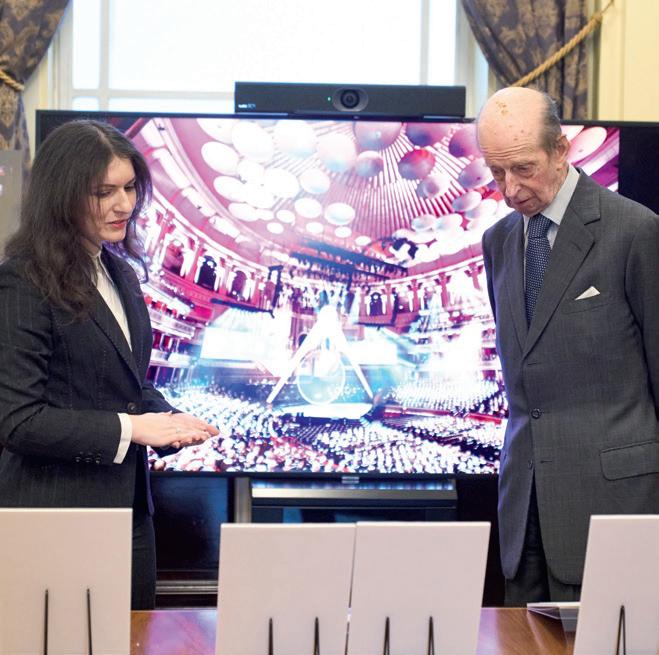
production process for this historical work. The Grand Master’s involvement with the project even extends to putting pen to paper as he will be contributing the foreword.
Please use this form to receive FMT, to notify us of a change of address or to request to be deleted from the FMT database. Do include the reference number found on the wrapper in which FMT arrived, where this is known. For a change of address, please fill in both your current and new address. Please tick the box below as appropriate:
I wish to receive a free copy of FMT I wish to notify a change of address I wish to be removed from the FMT database
Please state reason (resignation/not interested/ deceased/receive duplicate copies, etc):
Please return to FMT, Communications Department,
charge by every subscribing member of a lodge in London or a

In its historic 200th year, the Emulation Lodge of Improvement is marking its anniversary with a series of Festivals culminating in the Bi-Centenary Festival on Friday 6 October, which will be held in the Grand Temple at Freemasons’ Hall. On this occasion, the Committee themselves will demonstrate four sections of the lectures –including the Senior Member, Graham Redman PGSwdB, DepGSec – thus affording attendees a unique opportunity to observe Masonic ritual demonstrated to the highest standard. The lecture sections will consist of Section 1 of the First Lecture, Section 2 of the Second Lecture, Section 4 of the First Lecture, and Section 5 of the Second Lecture, and we are delighted that The Past Pro Grand Master, Peter Lowndes, has kindly agreed to be the guest of honour.
The Lodge has a long history. It first met on 2 October 1823 and has met without interruption ever since. It was one of a number of units that were set up to teach the new ritual ‘approved and confirmed’ by Grand Lodge in 1816 as a result of the unification of the former Antients and Moderns Grand Lodges. The ritual as taught at Emulation became known as Emulation Working, as such it is the ritual ‘name’ that follows the Lodge, not vice versa. It has always been the very rigorous policy of the Emulation Committee to preserve the ritual unchanged apart from any alterations specifically approved by Grand Lodge – notably the removal of the physical penalties from the obligations in 1986, and more recently the lowering of the minimum age from 21 to 18.

Unfortunately, exactly what was originally approved and confirmed has never been documented. Grand Lodge minutes state that the ceremonies were ‘demonstrated and met with approval and confirmation’, but there is no written record of what was demonstrated and, as such, the ritual had to be transmitted by word of mouth through bodies such as Lodges of Instruction. The Emulation Committee genuinely believes that it has preserved the original, but this can be neither proved nor disproved – hence an important point made in the 13th edition of the Emulation ritual book: ‘no suggestion is made, nor should it be made, that any one system of ritual is “right” and the others “wrong”. Private Lodges are free to choose their own system, and the choice and traditions of the Lodge in this regard should be paramount’. The business of Emulation Lodge of Improvement, as we see it, is to demonstrate a system that we believe to be as nearly as possible that which was approved originally, and which private Lodges may choose to use.
In the early years, the form of instruction at Emulation was entirely by rehearsal of the system of Masonic Lectures that had been developed by the Grand Stewards’ Lodge. Masonic Lectures have
The Emulation Lodge of Improvement will celebrate its Bi-Centenary in October 2023, marking it out as the oldest institution continually meeting to demonstrate ritual in the English constitution
a very long history, way back into the 1700s and predating the ceremonies as we more-or-less now know them by many years. A number of lecture systems grew up, and they themselves required modification to follow what was ‘approved and confirmed’ in 1816. The Grand Stewards’ system was not the only one but, maybe by virtue of the prestige attached to the Grand Stewards’ Lodge, it was widely viewed with favour. For several years it was demonstrated by the Grand Stewards themselves in their ‘public nights’. By about the 1830s, the ceremonies themselves were being rehearsed at Emulation, while continuing to demonstrate the Lectures, which is still done to this day. The Grand Stewards’ public nights gradually faded away; thus Emulation Lodge of Improvement is now the only place where the Lectures can be heard on a regular and frequent basis. The Lectures themselves have become widely known as ‘the Emulation Lectures’, but this is incorrect. They came from, and still formally belong to, the Grand Stewards’ Lodge and hark back to the 1700s when people’s ideas of what Freemasonry was trying to do were somewhat developmental and so, in this sense, they have real historical interest. However, they have many more facets: some of them illustrate ideas of delivering the ritual by a catechetical breakdown of the ceremony; others develop moralistic and, if you will, spiritual themes; and many of them contain really beautiful pieces of prose. They really ought to be heard much more often! Of course, some Provinces do run ‘lecture festivals’ – Surrey by way of example – perhaps on an annual basis, but there really is no reason why individual Lodges should not occasionally have one (or more) of these Lectures, perhaps especially if there is no other work to do.
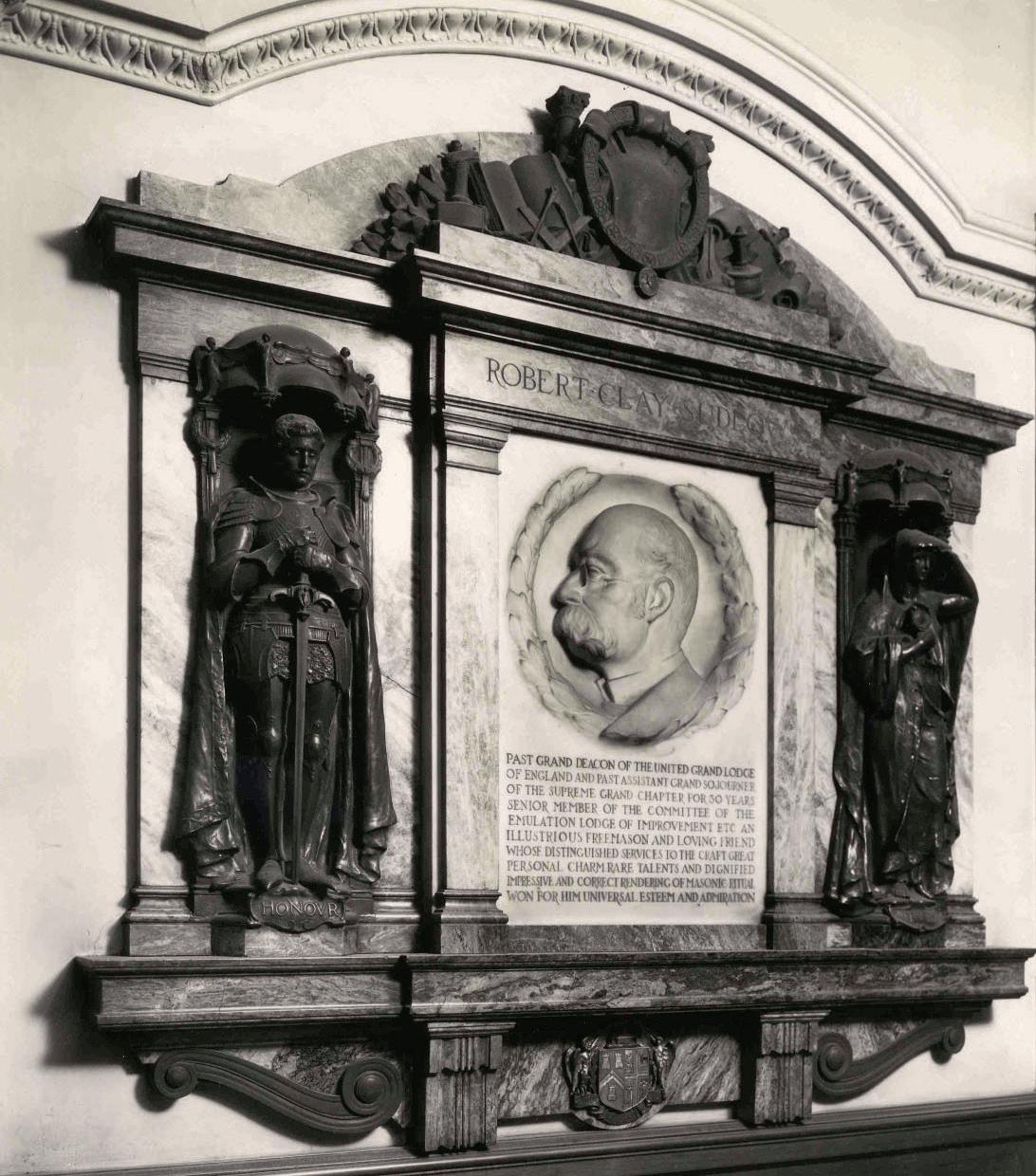
On 22 October 1897 Major RLS Badham, who was occupying the Chair, worked the second degree in a manner described as exemplary by the then Senior Member of the Committee, Robert Clay Sudlow, who was precepting on that occasion. Sudlow subsequently presented him with a silver matchbox to mark the achievement; he also – at his own expense until the rest of the Committee decided that he should be relieved of the burden – made similar presentations to other Brethren attaining a similar standard.
Within a few years it had become the established custom, and a Brother who works a ceremony from the Chair ‘without standing in need of prompting or correction’ receives a silver matchbox, engraved on the front with his name and on the reverse with the heading ‘E. L. of I.’ and beneath it the ceremony he has worked, together with the year (e.g. ‘2nd. Deg. & T.B. 1975’). If the Brother subsequently works a different ceremony without correction, that is recorded in the same fashion, and if he has worked all four ceremonies without correction, the words ‘Complete Record’ are added at the foot of the list.
In order to qualify, the ceremony must be worked by the Master without any mistakes in either words or actions.
As at the end of May 2023, 367 brethren have received a matchbox, of whom 121 have achieved a complete record. There is no doubt that over the years many brethren have been inspired to work at Emulation Lodge of Improvement by the prospect of achieving this unusual accolade. It must however be emphasised that a matchbox is an indication only of strict accuracy; it says nothing about the quality or impressiveness of the ceremony. Some word-perfect ceremonies can only be described as pedestrian, while conversely many brethren whom the matchbox has eluded to the end of their days at Emulation have worked inspirational ceremonies of which anyone could be justly proud.
Emulation Lodge of Improvement meets every Friday throughout the year except for a summer break (July, August, September), a four-week Christmas break and Good Friday. They are held at 6.15pm in Freemasons’ Hall, usually in Room 9. Most meetings consist of a ceremony on a rolling four-week cycle: First, Second, Third, Installation. Each time, the ceremony is followed by a Lecture. There are 15 Lecture Sections, each of which is demonstrated at least twice in the year. The dress code is ‘smart casual’ but definitely jacket and tie; regalia is provided.
On two occasions in the year the usual practice is departed from. On the last Friday in February the Annual Festival is held when a distinguished brother, usually a Provincial Grand Master, presides. The principal offices are filled by members of the Committee and selected brethren assist in working sections of the Lectures. On this occasion the offices of Deacon and Inner Guard are filled by members of the Grand Stewards’ Lodge in token of their surveillance of our working of the Lectures according to their custom. On the last Friday in June the normal work is undertaken by brethren recommended by the Preceptors of ‘Recognised’ Lodges of Instruction operating in Provinces across the country. On both the Festival occasions the brethren dine together afterwards.
Tickets for the Bi-Centenary are available for Temple and Dining, and for Temple only, and can be purchased via www.emulationloi.org
Derbyshire Freemason Martin Ward went from being a marathon spectator to completing 100 runs for charity
Martin Ward was introduced to Freemasonry more than 20 years ago when he was initiated into the Lodge of St John No. 8070 in Belper, Derbyshire. He’s had the honour of being Worshipful Master and is currently Almoner. ‘I am a member of most of the other orders in Freemasonry and have been in the Chair of all of them, which pleases me immensely,’ he says.
What inspired you to take up running?
Following early retirement, I was overweight and taking no exercise. I went with my wife to see my son Richard run the Conwy half-marathon and was totally enthralled by the sight of runners starting off from Conwy Castle and around the coast to Llandudno and back. I told my wife that I would like to run that race, which she found amusing because of my unhealthy state. But in December 2013, I walked from my house to the first lamp post on the street, then gently jogged to the next post, repeating this walk-jog routine. Eventually, I ran around the block, then to my allotment just over one mile away. It was a revelation. I could run!
I started doing my local parkrun each Saturday and loved it. I bought a proper pair of running shoes and entered the Great Manchester Run (10km), which also happened to be the great runner Haile Gebrselassie’s last race. The IAAF
World Half Marathon Championships in Cardiff soon followed. I finished well within the top half of all the runners.
And your first full marathon?
The Nottingham Robin Hood in 2015. I ran to raise money for the Derby Nightshelter. Over the years, I’ve set up fundraising groups and raised many thousands of pounds through events. I cannot bear the thought of people sleeping rough in freezing winter conditions. Charity is at the core of Freemasonry and I hold it close to my heart.
What spurred you on to run more?
After my first marathon, I caught the bug for endurance running and was competing in three or four marathons each year. But two years ago, my son Richard decided to take on the challenge of 52 marathons in 52 weeks, which included the world’s hardest – 10 in 10 days, up and around the roads of the White Cliffs of Dover in winter. I thought I would keep him company on some of the races and ended up running 35 that year, then 35 the next. At that point, I thought my 100 was possible.
I discovered my love of extreme distance running. I had a third place over-50 at one of the big races and a second at over-60 a year or two later. In
2022, I placed 92nd out of 770 runners at the Endure24 in Leeds, and I ran 65 miles.
Among other good results was an ultra-marathon in Northamptonshire, where Richard won the race and I came third – making us the oldest father and son in the UK to podium place in the same ultra-marathon.


In December, I became the oldest man in the UK to win two ultra-marathons in three days. It was below freezing in Milton Keynes, but I just kept going and took first place over 50km. The conditions were even worse for the second race, which was the World Cup Ultra Marathon. A photograph after the race shows my face covered in a veil of ice, as my breath had frozen from eyebrows to my chin.
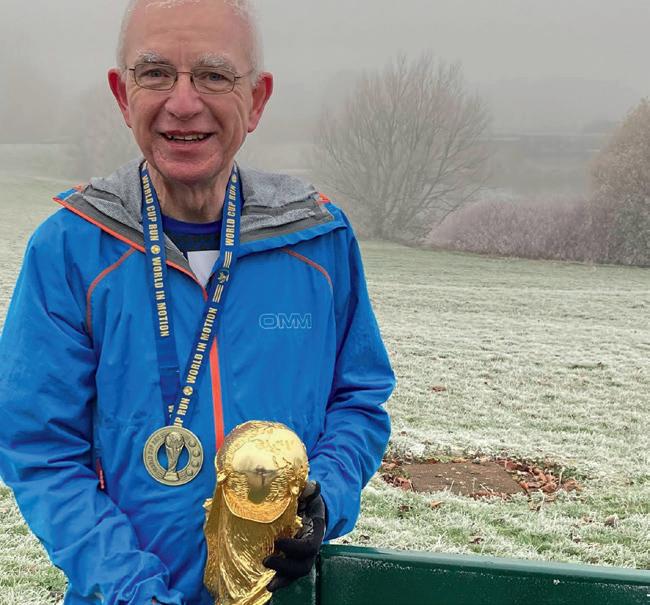
How did you feel about completing your 100th marathon?
My 100th was a wonderful occasion, although the hottest day of the year to date meant that it was a struggle to finish. I had to complete it, though, because I was running to raise money for The Padley Group, which helps homeless people. I was elated. I had become one of the oldest men to complete 100 and became a member of the fabled 100 Marathon Club of the UK and Ireland.
How did you celebrate?
With a meal at a local hostelry. Then I drove back home to Derbyshire, where my wife had a congratulations card waiting for me. It is a tradition that runners completing 100 marathons supply cake to the other runners, so two very big cakes were on a table at the finish line.
Do you think Freemasonry has helped support you in your adventures?
I am proud to be a Freemason and tell people so. As members know, ritual teaches us not to be afraid, and this is important in extreme endurance sports. Charity being at the heart of Freemasonry tallies well with my personal commitment to helping others. It is the most wonderful level of friendship which has the deepest and sincerest foundation for anyone.
Any more marathons planned?
Number 101 is already booked to raise money for the St John Eye Hospital in Jerusalem. I am hoping to run more longer-distance races – perhaps 100 miles – now that I am 65, which I hope will inspire others to keep fit.


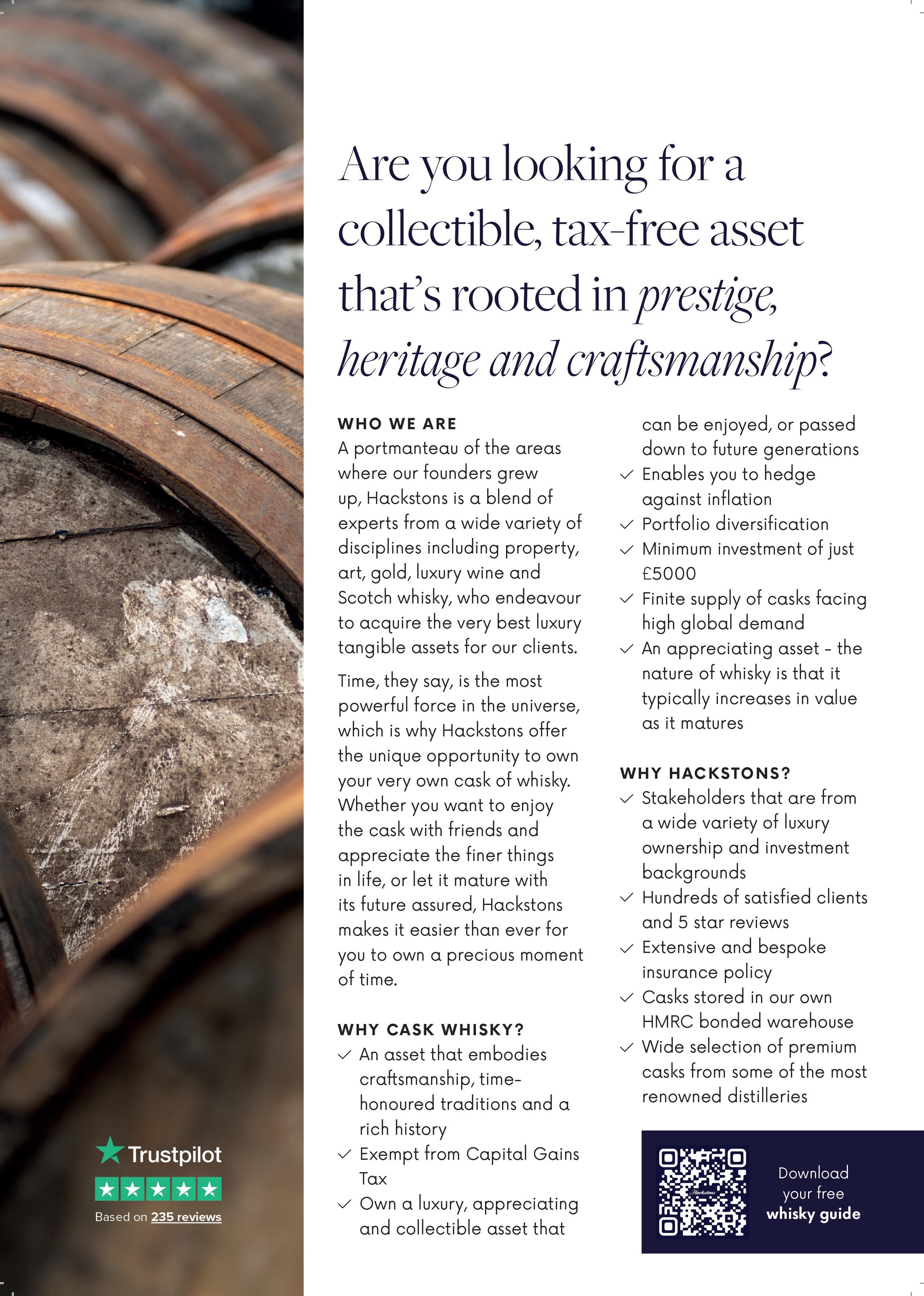



A year into his role as Grand Secretary, Adrian Marsh talks about steering the success of UGLE’s seven-year Strategy and optimising the Freemasonry experience for members
 WORDS PETER WATTS PORTRAITS JOONEY WOODWARD
WORDS PETER WATTS PORTRAITS JOONEY WOODWARD
When Adrian Marsh is walking his two dogs around the neighbourhood outside Rickmansworth, Hertfordshire, his favourite route invariably takes him past the Royal Masonic School for Girls. The sight of that school acts as a reminder of the history, achievements and principles of Freemasonry, something further reinforced when he is at Freemasons’ Hall in his role as UGLE Grand Secretary and Grand Scribe Ezra in Supreme Grand Chapter. In both buildings, he sees a pattern and philosophy that he believes still resonates.
‘Our forefathers believed in what they were doing,’ says Adrian. ‘It was a simple creed: how do you improve the society in which we are living? It’s a question we can still ask today. With Freemasonry, it doesn’t matter what colour or what religion you are, or where you went to school. It’s an inclusive organisation with a clear purpose.’
As Grand Secretary, Adrian Marsh wants to optimise UGLE’s unique asset - Freemasons’ Hall


Adrian was confirmed as Grand Secretary in September 2022, replacing the outgoing Chief Executive and Grand Secretary David Staples. He will take the traditional Grand Secretary role, while still performing many of the functions of a Chief Executive within UGLE’s organisational structure.
The offer to be Grand Secretary came from Pro Grand Master Jonathan Spence in 2022. Adrian was already part of the wider UGLE team, using his skills as finance director of a FTSE 100 company to help the Board of General Purposes. Jonathan had discovered that Adrian was thinking of retiring from his professional role – which he announced in September 2022 – and invited him to lunch, having spotted an opportunity to add another name to the first-rate executive team he has built to execute UGLE’s seven-year Strategy.
‘Having heard Jonathan’s vision, I found myself nodding very enthusiastically and saying I wanted to support Jonathan with his ambition. He asked me candidly if I thought we could get things working, was the Strategy doable and did I want to be part of it. While I wanted to retire from executive life, I didn’t plan on doing nothing. It was very exciting, and I definitely wanted to get involved.’
Adrian originally became a Freemason, he confesses, partly to impress his future father-in-law – a member and long-term Secretary of Strong Man Lodge No. 45. Adrian loved the experience and soon became an active Freemason. After stepping away from Freemasonry to focus on his career and family, Adrian has engaged with the Craft with renewed enthusiasm in recent years, having found that some of the themes and principles have taken greater resonance over time. It has helped that he can share his Freemasonry with his family – he presided over his son’s third degree in June and recently attended his son-in-law’s Initiation at Watford Lodge No. 404.
‘He knew I would turn up at the ceremony, but didn’t know I would carry it out,’ says Adrian. ‘So it was very amusing on entering the Lodge that the first voice he heard was mine.’
Having spent almost four decades in the City, Adrian joins a leadership team at UGLE that has a potent mix of talent and experience. His role
as Grand Secretary involves acting as the link between the Rulers and the Board of General Purposes. With his background in finance and commerce, Adrian is exploring ways to optimise commercial income from Freemasons’ Hall while also exercising a tight grip on cost management.
There will be innovations, such as closer collaboration with the women’s orders, Royal Arch and companion orders and, in Wales in September, the first Quarterly Communication to be held outside London since the war. Above all, he wants to improve the experience for members.
‘We are a membership organisation,’ he says. ‘The member experience needs to be the most important thing – whether it’s the process of joining, when you receive Grand Rank, when you come to Grand Lodge or when you are visiting or have a meeting at Freemasons’ Hall. The Grand Secretary’s role is to ensure we are organised effectively to deliver that members’ experience and optimise our unique asset – Freemasons’ Hall – to be enjoyed by members and maintained for future generations. My role is to apply the industry approach to UGLE. That means sharing best practice, allocating resources and facilitating change – but not sitting in an ivory tower pointing a finger and saying this is what you should be doing.’
Growing the membership will require evolution and flexibility to meet the demands of a younger generation. That might mean more Lodge meetings in the early evening rather than late afternoon, and adapting the Festive Board to suit the pockets of younger members. After his son’s third degree, the Festive Board took the form of pizza in the courtyard at Freemasons’ Hall, while others have featured sharing a curry rather than a traditional three-course meal. Adrian knows himself it can be hard to maintain Masonic life while juggling young children and/or professional commitments. Here, Lodges can support absent members by keeping them informed of developments and making them feel appreciated and welcome.
‘These are things everybody can do, and we want to support and facilitate the energy and ideas and good practice,’ says Adrian. ‘We use the Magazine for that as much as we can, but it has to be done at the grassroots level – and we are already seeing some great examples. As I wind down from my executive life, I’m starting to get out and about and I can see that energy in Lodges across all of UGLE. At HQ, we’ve made changes to the leadership team and put in place a new structure, and are looking to build a team for the future. We want to bring out the best in people and ensure we are all aligned to the Strategy and understand the importance of the membership experience. That’s the excitement for me, working with a team who share that desire and enthusiasm and have a similar view on what success might look like. The key to any success, though, is that it must resonate at Lodge level.’
‘We are a membership organisation. The member experience needs to be the most important thing’
The Battle of Thiepval Ridge. General Haig explains the capture of Thiepval to King George V from the top of Thiepval Chateau, October 1916
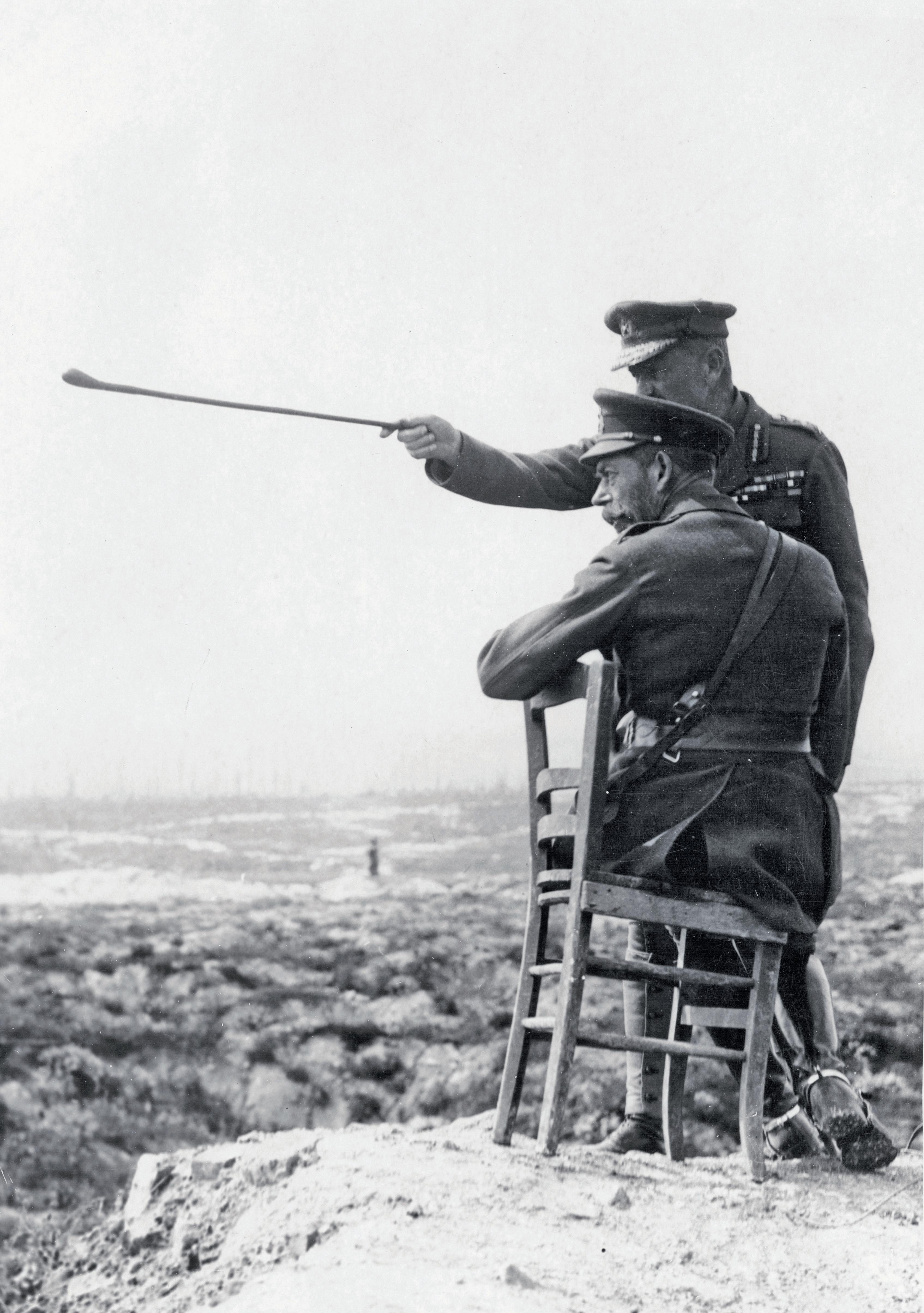
As the ‘Brothers in Alms’ exhibition opens at Freemasons’ Hall, Craftcast: the Freemasons Podcast invited Brian Deutsch to share the inspiration behind the display of rare wartime photographs
The ‘Brothers in Alms’ exhibition has taken up residence at Freemasons’ Hall. It’s an immersive journey that unveils a remarkable assortment of rarely witnessed wartime photographs. In order to delve deeper into the captivating narrative of this exhibition, Craftcast: the Freemasons Podcast extended a warm welcome to exhibition curator Brian Deutsch as a special guest in the studio.
During his appearance on Craftcast, Deutsch shared the fascinating story of how he
came to possess this extraordinary collection, information about the history behind the exhibition and its relationship to Freemasonry.
In the late 1980s, during his tenure in the cable television industry, Deutsch obtained the collection that ultimately gave rise to the exhibition.
He told Craftcast, ‘Well, a strange thing happened. I got a message via telex from my office in London telling me that the BBC was thinking of selling the Hulton Archive.’
The large collection of photographs was named after
Sir Edward Hulton, a prominent figure in the publishing world. Sir Edward was the owner of Picture Post, a UK magazine that shared captivating stories in a photojournalism style similar to Life magazine in the US.
From its creation in 1938, Picture Post ran for 20 years. It proved an instant hit and sales increased further during World War II, attracting more than 20 million readers.
Deutsch said, ‘The magazine was successful and featured many now-famous news photographs. It also amassed a vast collection of pictures.’
In addition, Picture Post explored historical events with centenary editions that featured fascinating images sourced from various libraries. Often, these images were bought by Picture Post – forming the Hulton Archive.
Despite his limited expertise with photography and the collection’s contents, Deutsch acquired the Hulton Archive. To compensate for the gap in his knowledge, he recruited the head of Christie’s photographic department for guidance.
‘What I discovered was not just these wonderful photos from the war and 1938 onward,
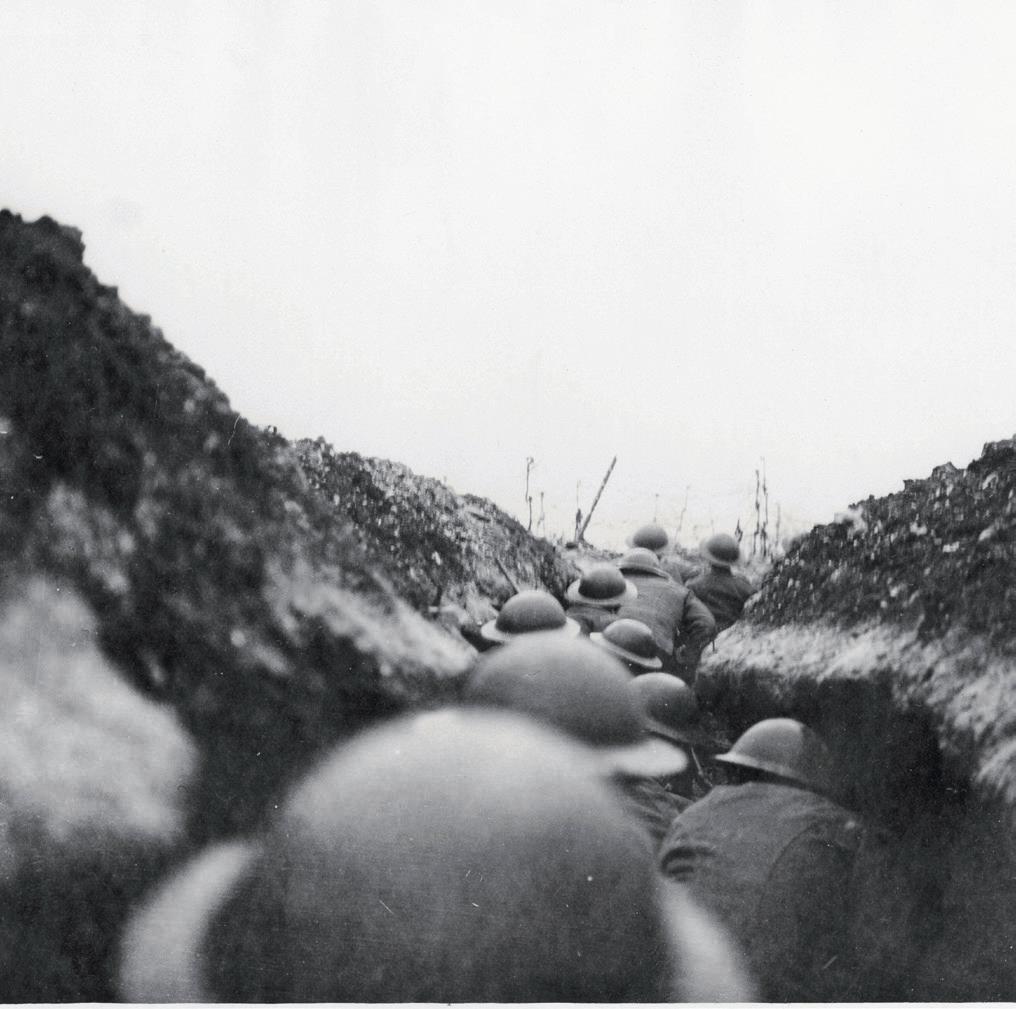
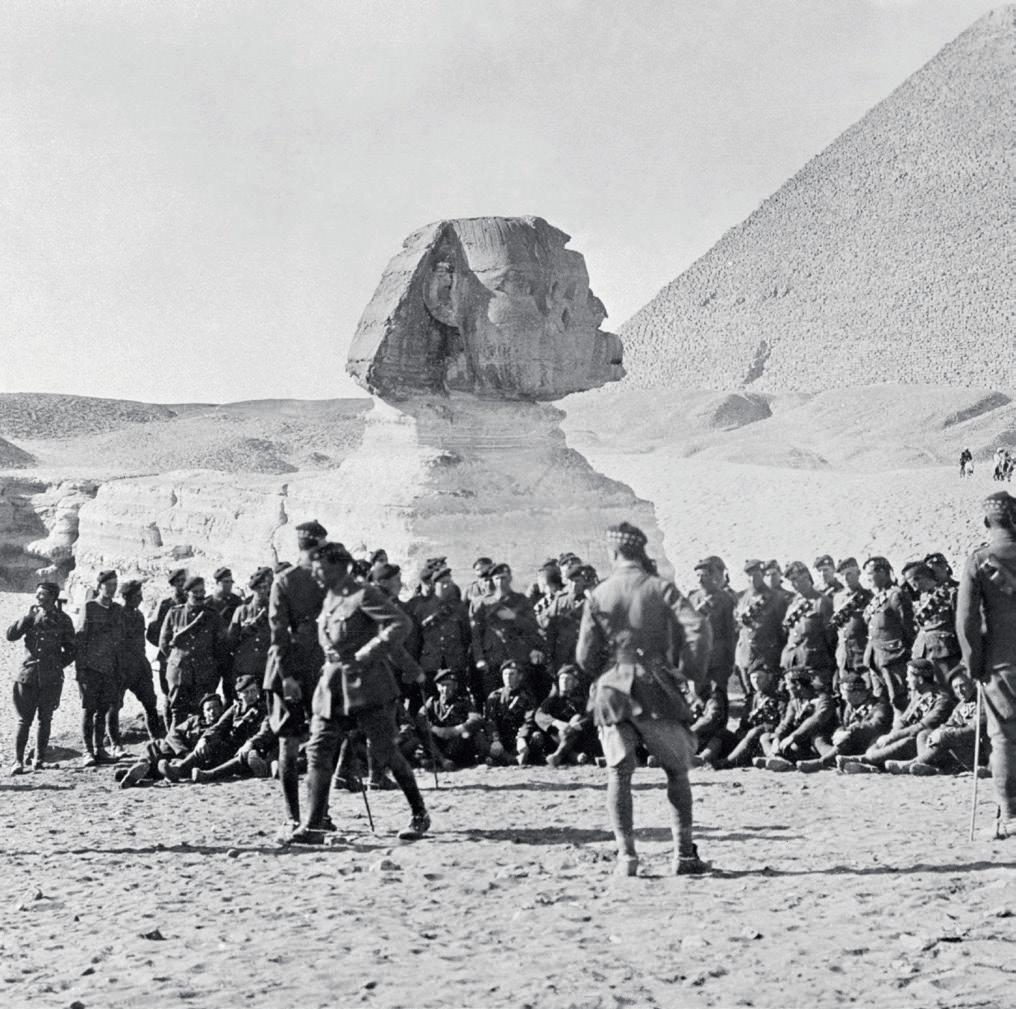

but an amazing archive of historic images,’ he said. ‘We used to go around in the middle of the night – what I called “Hulting” – and open drawers and find these amazing pictures.’
He added, ‘The collection was outstanding, but what do you do with it? As a private collection, it’s not going to be of much use, so I said that we’ve got to make this available to other people.’
Deutsch explained how the only way to share the images was to drum scan 100,000 pictures, a time-consuming and expensive process.
During that period, Deutsch had the opportunity to meet Bill Gates and invited him to see the magnificent collection of images. Gates unfortunately declined the invitation.
Deutsch added, ‘The joke is, after £1 million was spent on scanning them, Gates paid me £2.5 million a couple of years later for 50,000 images for the digital encyclopedia Encarta .’
The collection of images was transformed into CD-ROMs, with each disc containing 5,000 pictures spanning 1900 to 1950.
‘People started to see what these images meant and were able to copy them and get
rights for them for much more than just sending them out. It became quite a meaningful business and I ran it for nearly 10 years,’ he said.
After a period of time, shareholders of Deutsch’s company decided to sell it to Getty, the online image library.
For 20 years, Deutsch had not revisited the Hulton Archive. However, his friend and Freemason Quentin Humberstone approached him with a compelling request – to return to the image archive and curate an exhibition commemorating
the centenary of the end of World War I.

To start, Deutsch handpicked 240 pictures from the archive, as well as from a diverse range of sources such as Alamy, the National collections of Scotland and other image libraries.
The purpose behind the exhibition was to shine a spotlight on the acts of benevolence performed by individuals during the war, including the contributions of Freemasons.
Deutsch aimed to shift the narrative away from the prevalent emphasis on bloodshed, injury and tragedy, and direct attention towards the positive endeavours of humanity amid the tumultuous period.
‘We needed to show the spirit of brotherhood,’ he said.
When asked about the inspiration for the exhibition, Deutsch explained how there was something really special about pictures.
He said, ‘Since I bought this collection in 1988, I’ve always believed that a picture says a thousand words. Pictures are the most evocative way of sharing stories, especially if they recall real events. You look at a really good image of someone’s face and you can see the pain or the pleasure.’
Deutsch highlighted the extraordinary nature of these captivating pictures, showcasing aspects that surpass the limitations of history books, allowing them to convey stories that words alone cannot capture.
Highlights of the exhibition include images of a number of remarkable Freemasons and women Freemasons who served throughout the war, such as Field Marshals Horatio Kitchener and Douglas Haig.

Deutsch had no intention of singling out Freemasons –it just so happened that
there were quite a few in the exhibition’s images.
‘I was quite surprised,’ he said. ‘Yes I knew some of the leaders were Freemasons, but to find so many that were fighting in the war who were lower down in the ranks was absolutely amazing.”
During the Craftcast interview, Deutsch revealed his two favourite images from the exhibition, both of which gained the favour of the Grand Master, HRH The Duke of Kent when he gave him a personal tour.
Deutsch said of The Duke, ‘He was fascinated by the whole thing and he loved it all.’
Within the collection, Deutsch showed His Royal Highness two pictures featuring his own grandfather, King George V. The first image depicted the King presenting one of 500,000 medals to a soldier on the front line during World War I. The Duke was astounded to learn of his grandfather’s regular visits and involvement with the front line during the conflict.
The second image held equal importance, capturing Haig using his cane to illustrate the details of the momentous battle of Thiepval to King George V. The King is portrayed sitting on a small chair, attentively listening to Haig’s explanations about the battle’s course.
‘It’s a marvellous picture,’ he said. ‘You can see the closeness of these two human beings.’
During his discussion on Craftcast, Deutsch highlighted the correlation between World War I and the surge in membership within the Freemasonry community.
He said, ‘It’s one of the reasons people came into Freemasonry. They thought: “Where can I go to have this camaraderie that I have had for these four horrible years?”’
Deutsch went on to explain how many soldiers in the
trenches had friends around them that were already Freemasons, which inspired them to join after the war.


When asked about how he came up with the name for the exhibition, Deutsch said that it was important to highlight brotherhood rather than charity.
‘It’s a bit corny but the idea is that you usually say brothers in arms. But I thought the truth of the matter is that what this building [Freemasons’ Hall] is all about is the alms, the charity, the good deeds that are done, the hospitals that were set up by Freemasons during the war.’
Tours of the ‘Brothers in Alms’ collection will be available monthly, but Deutsch is happy to do them as often as people want for groups of Freemasons as they pass the collection on the second floor on the way to Lodge rooms.
He said, ‘I’m very happy to take those people and say let’s show you what this is really all about and how this relates to you and this great building.’
Members of the public can view the collection without a guided tour, but to get the real story and narrative behind the pictures Deutsch suggests it’s best to go on a guided tour.
If you’re interested in booking a tour with him, email: tours@freemasonshall.com.
Tune into Craftcast: the Freemasons Podcast, to hear the full interview with Brian Deutsch about the exhibition. It’s available on all major podcast platforms.
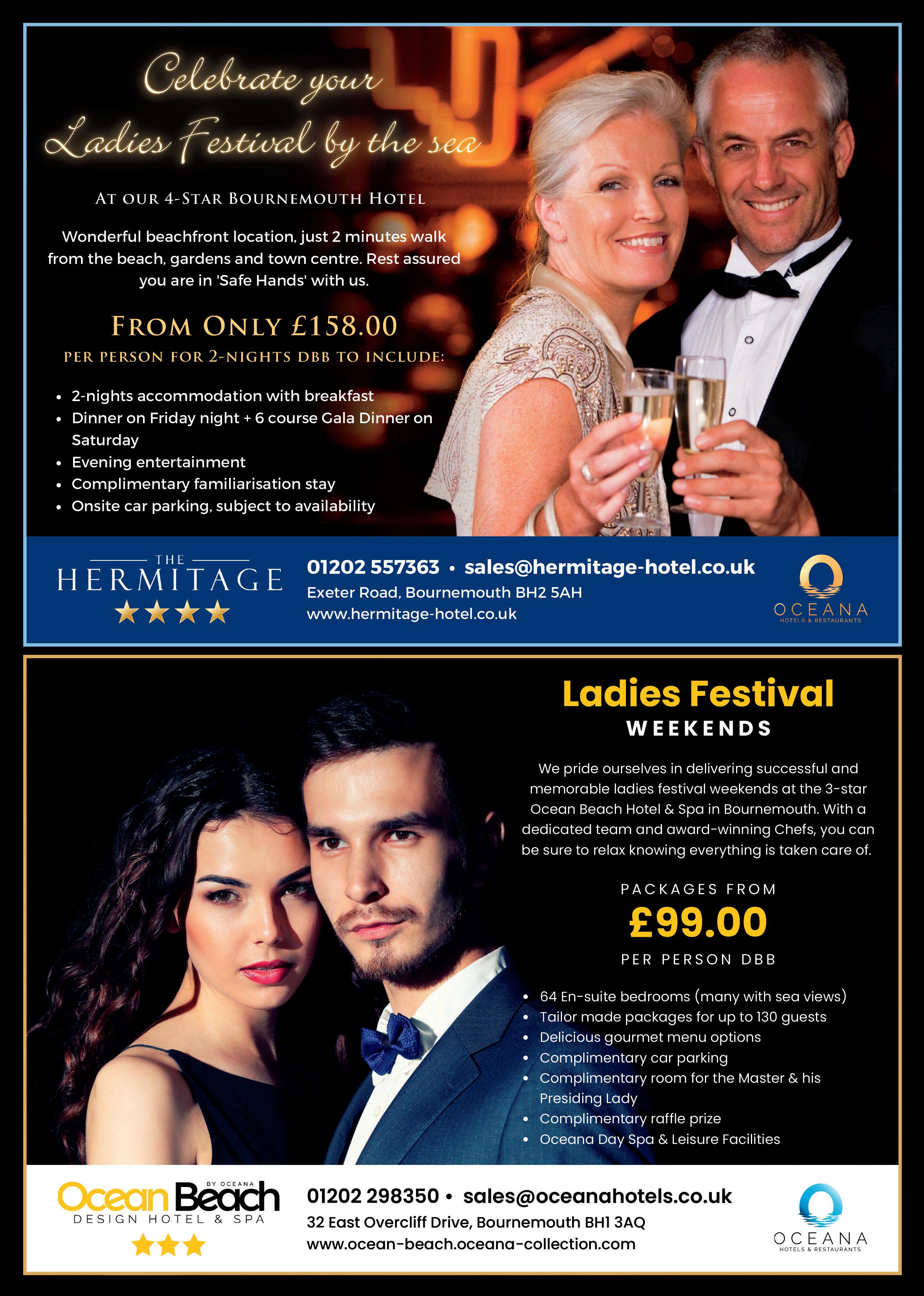

 Shop at Freemasons’ Hall
Shop at Freemasons’ Hall


On 5 September 1923, with the Pro Grand Master Lord Ampthill in charge, the United Grand Lodge of England held a Quarterly Communication outside London. More than 2,200 Freemasons packed into St George’s Hall in Liverpool for this historic occasion – one that had required a rewrite of the Constitutions.
In the previous century, it was not unusual to hold Grand Lodge meetings away from London. However, these were special meetings with a specific reason, such as laying the foundation stone of an important building. In 1844, for example, the Earl of Zetland laid the foundation stone of the Penshaw Monument near Sunderland. In 1880, the Prince of Wales laid the foundation stone of Truro Cathedral, followed by a meeting of Grand Lodge in Truro Town Hall.
The Duke of Sussex found the most reasons to hold special Grand Lodges outside London during his tenure as Grand Master between 1813 and 1843. Along with frequent foundation stone ceremonies, he held Grand Lodges to install Provincial Grand Masters. In 1833, he met with Freemasons in Nottinghamshire and, in 1841, held a Grand Lodge in York to reprimand members of a Lodge for ballot-rigging against candidates.
These were always special meetings because Rule 11 of the Constitutions stated that: Four Grand Lodges shall be holden in London, for Quarterly Communication, in each year, viz., on the first Wednesday in the Months of March, June, September and December.
In May 1921, Grand Master, the Duke of Connaught, was approached by Provincial members of the Board of General Purposes suggesting that it would benefit the Craft to hold the September meeting of Quarterly Communication outside London. A committee was set up, chaired by Board President Sir Alfred Robbins, which agreed that some meetings could be held outside London. In 1922, after a vote in Grand Lodge, Rule 11 was amended to: the Meetings in September shall be holden in a place as may from time to time be determined by the Grand Master.
After the Liverpool meeting in 1923, Grand Lodge held another four September meetings outside London: Birmingham in

In September, the Quarterly Communication of Grand Lodge will be held in Wales. Museum of Freemasonry’s Martin Cherry looks back to the last time this happened
1928, Newcastle in 1934, Manchester in 1935 and Leeds in 1937.
When the idea of these meetings was first proposed, some London members of Grand Lodge had suggested they would be poorly attended because no one would want to travel. It proved to be the opposite. The attendance by Provincial members was much higher, with 88 per cent of the 2,209 members at the Liverpool meeting being Provincial Freemasons in contrast to the 14 per cent of the 765 members who attended the London meeting in September 1922.
These meetings were also taking place when Freemasonry was going through a growth period, with membership increasing after World War I. The old Victorian Freemasons’ Hall had a relatively small capacity, and even the new hall being built only had space for about 1,500. The five Provincial meetings were all held in large venues, with the greatest number attending Quarterly Communication at Manchester’s Free Trade Hall in 1935.
The five events were not a novelty, but serious meetings of Grand Lodge in which important business was conducted.
In Liverpool, members voted the sum of 2,000 guineas in relief funds for the Japanese earthquake. At the meeting in Birmingham Town Hall in 1928, Lord Ampthill announced the restoration of Masonic privileges to Freemasons born in an enemy’s country, suspended since 1915. The 1934 meeting at Newcastle’s City Hall saw the introduction of Bi-Centenary bars on Centenary Jewels for Lodges reaching that milestone. At the Leeds Town Hall meeting in 1937, Grand Lodge turned down an appeal from Lodges and Provincial Grand Lodges to send aid to Abyssinia (Ethiopia), under invasion from fascist Italy, on the grounds that this would be a political action.
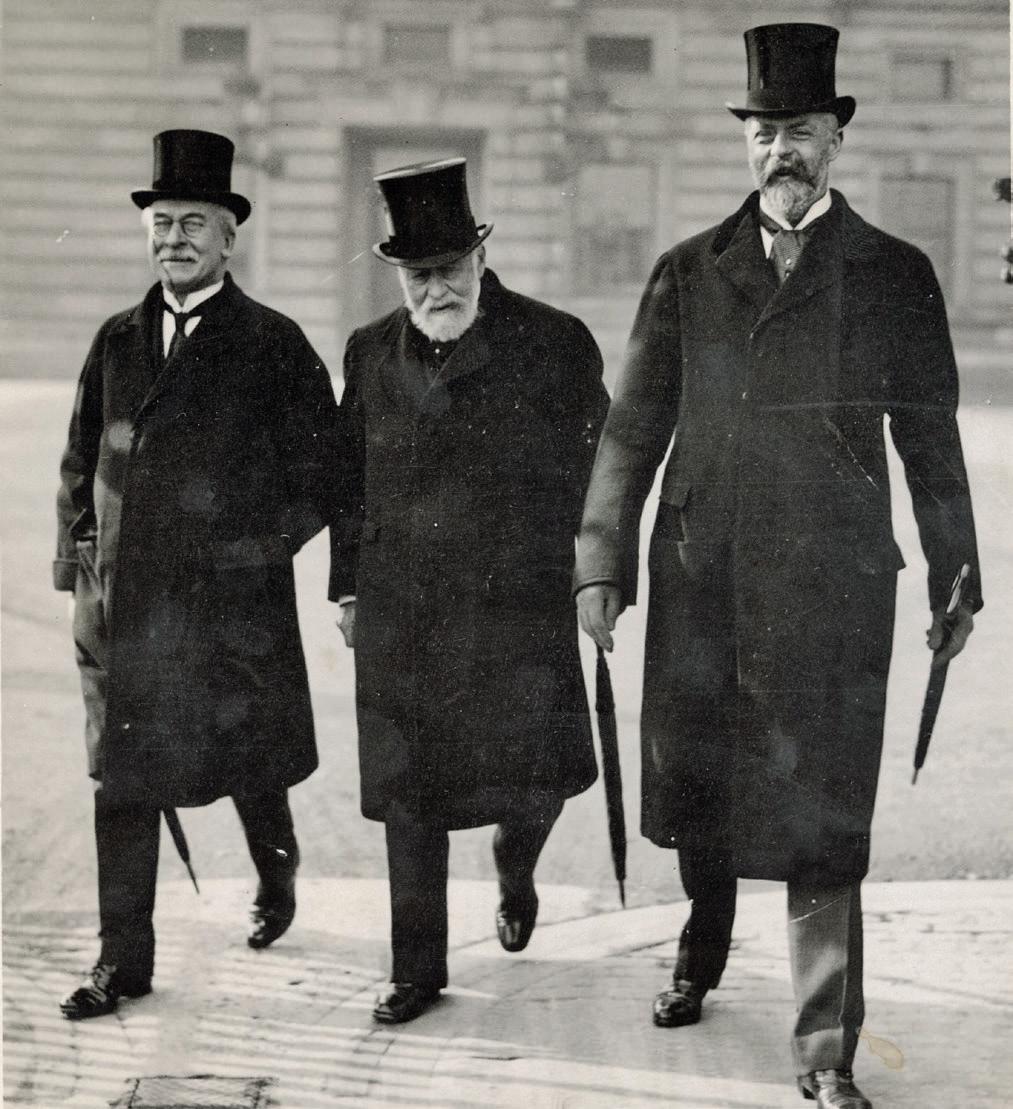
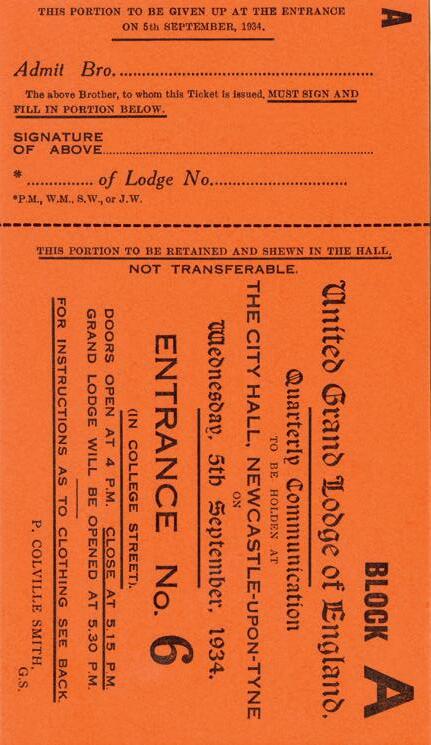
Two years earlier, the Manchester meeting had mourned the loss of Lord Ampthill, with his cousin the Earl of Derby taking the throne for the day. The Earl was the Provincial Grand Master of Lancashire Eastern Division and must have been experiencing mixed emotions, representing the Grand Master, but at the same time remembering Ampthill, who had been Pro Grand Master for 27 years.
The meetings were successful in
bringing Provincial Freemasons to Quarterly Communication, but they also helped to raise the profile of Freemasonry. Alfred Robbins had a background in journalism and was keen to keep Freemasonry in the press for positive reasons.

The Liverpool meeting attracted plenty of coverage, with the Liverpool-based Daily Courier reporting that the Mayor of Liverpool entertained the officers of Grand Lodge at the Walker Art Gallery and that West Lancashire was the largest Masonic Province.
Both the Liverpool Daily Post and the Daily Mail carried pictures of Lord Ampthill visiting stonemasons at Liverpool Cathedral and The Times reported on the earthquake relief fund. It is not recorded why 1937 was the last of the Quarterly Communications to be held outside London, although the deaths of Robbins and Ampthill must have been contributing factors, along with World War II.
It will be interesting to see the impact of September’s meeting in Newport and if it emulates the run that began 100 years ago.
This page, clockwise from top left: Embroidered badges for RMIB Festival in 1870 and RMIG Festival in 1871, presided over by the Prince of Wales, later King Edward VII; the Duke of Connaught’s personal jewel for 1882; the RMIB badge for 1878 with the coat of arms of its President, the

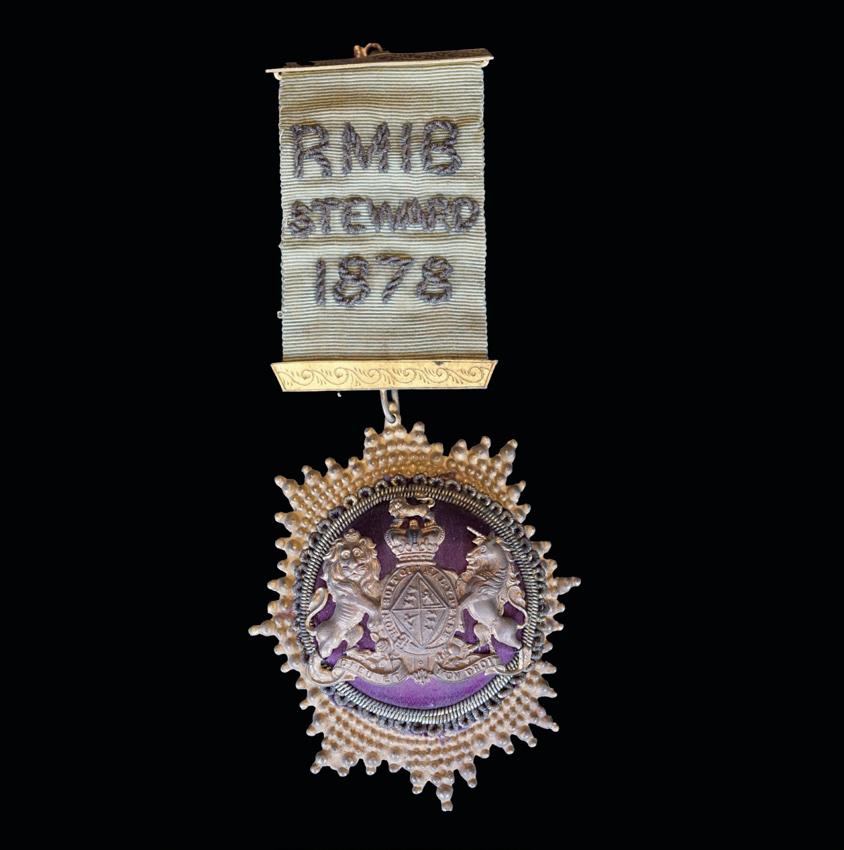


The first of the three principal Masonic charities, the Royal Cumberland Freemasons’ School for Females – later the Royal Masonic Institution for Girls (RMIG) –was formed in 1788. The second, the Royal Masonic Institution for Boys (RMIB), was founded 10 years later. The Royal Masonic Benevolent Institution (RMBI) became the third in 1842.
All three institutions relied on donations from Freemasons and their families. Depending on the amount given, this could be rewarded by an honorific, such as patron or life subscriber. Wives and children who contributed would receive the same recognition for half the relevant sum.
Almost from its foundation, it was customary for the RMIG to hold an annual Festival, comprising a concert and a dinner, for fundraising purposes. As the other Masonic charities came into existence, they followed suit with their own Festivals. Those who acted as Stewards of a particular Festival would pay an additional Steward’s fee, for which, from 1859, they would be entitled to receive and wear a Steward’s badge of unique design to commemorate the event. Approval of the design for the badge would be granted by the President of the Festival, usually a Provincial Grand Master or another
Freemason of high rank. Women would also be entitled to attend the Festival dinner and receive a badge, which would sometimes vary in design from that worn by the rethren (and could be made by a different manufacturer).
The earliest badges were embroidered discs with tassels that could be pinned to the breast. Most of these were manufactured by George Kenning & Son and would sometimes feature colour variations on a basic pattern. Badges of this type disappeared completely after 1879, with some of the later ones featuring a metal design affixed to the embroidery.
Later jewels were usually of one of two patterns: either a metal jewel suspended from a vertical ribbon and fastened to the breast with a hinged stick-pin or a built-in clasp; or a metal badge attached directly to the breast or lapel with a clasp.
Occasionally, other patterns were used. Until World War II, the metal was usually silver, but versions in gold, sometimes inset with gems, might be specially made for the Chairman or President of the Festival, or guests of honour.
During this period, the firm of Spencer & Co, London had a virtual monopoly of producing Festival jewels, usually manufactured at its works in Birmingham. Just occasionally, other firms
would obtain the business, such as C Weeden & Sons, London in 1914 and George Kenning & Son in 1927, in both cases for RMIG Festivals. During World War I, tokens were made of cardboard as a result of the shortage of metal, but those who received them were entitled to exchange them for metal jewels at the cessation of hostilities.
Originally only worn at the Festival dinner, it was later permitted for Stewards to wear them throughout the year of the Festival. Additionally, approval was often granted by the Grand Master for the badge to be made permanent, allowing it to be worn during the lifetime of the Steward, but only within the Province hosting the Festival.

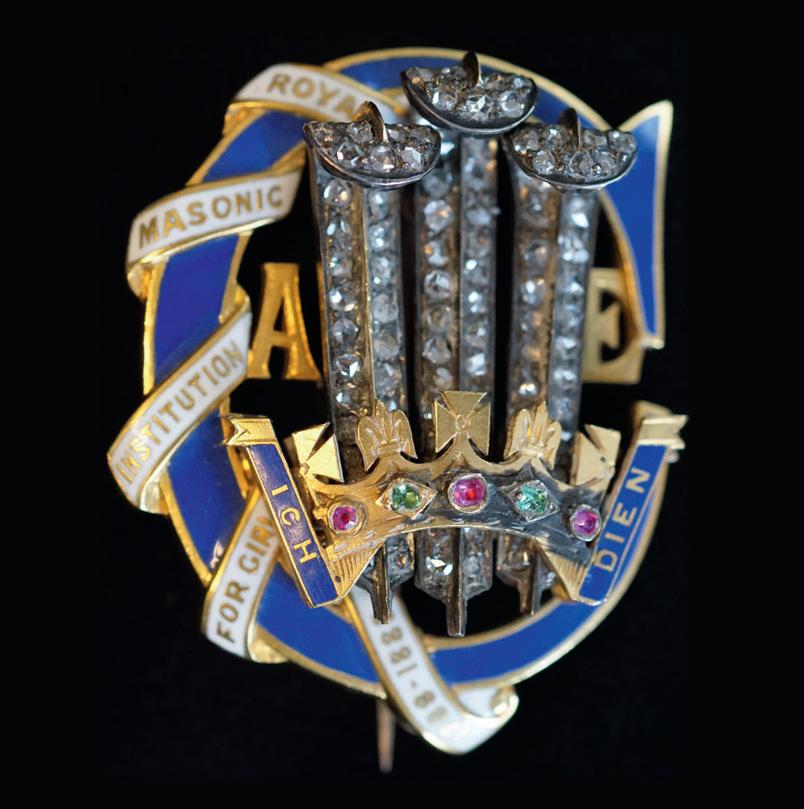
The early Festivals were attended regularly by the Duke of Sussex. Following his death in 1843, the involvement of the Royal Family with these Festivals ceased temporarily, but resumed after the initiation of Albert Edward, Prince of Wales, in 1868. Between 1870 and 1943, Festivals of the principal Masonic charities were presided over on 19 occasions by members of the Royal Family. At many, astonishingly large sums were raised for the charities concerned. In terms of today’s money, the aggregate would easily exceed £100 million. When a member of the Royal Family acted as President, the design of the badge would invariably reflect his royal status. The Museum of Freemasonry has examples of almost all such badges, some of which are quite exquisite and deserve to be better known.
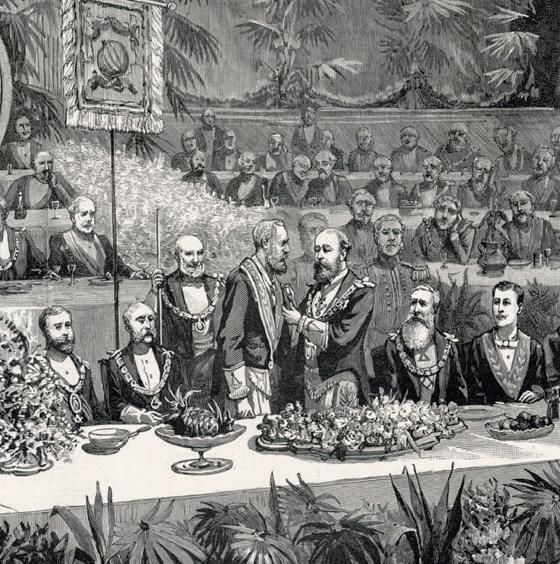
Badges of the early embroidered type were issued for three Festivals of the RMIB in 1870, the RMIG in 1871 and the RMBI in 1873, all of which were presided over by the Prince of Wales, later King Edward VII. None of these have any feature to indicate the institution concerned or the year of the Festival; the first two have only the Prince of Wales’s feathers as a decoration, while the third has the central part of his coat of arms.
The RMIB badge for 1878 was an example of an intermediate design, the embroidered token being suspended from a ribbon and having pinned to it
the coat of arms of its President, the Duke of Connaught, in metal. By 1878, the RMIG badge was made entirely out of metal, in the form of a breast jewel suspended from a ribbon, and featured the Prince of Wales’s feathers within a circlet. The Prince was indeed a patron of the RMIG and the example illustrated is the one presented to the Prince of Wales following the Festival dinner held at the Freemasons’ Tavern, but the President was the Earl of Carnarvon.
A simple example of an early metal jewel is that of the RMIG Festival of 1880, presided over by Prince Leopold, later Duke of Albany, Provincial Grand Master of Oxfordshire. The obverse design is simply his monogram, L, surmounted by a Royal crown.
Considerable variation could occur in the quality of the Festival jewels for a given year, notwithstanding an agreed basic design. Examples of this are provided by the jewels for the RMIG Festivals of 1882 and 1888, presided over by the Duke of Connaught and the Prince of Wales respectively. The Museum holds Connaught’s personal jewel for 1882, which differs in three ways from the basic jewel: the ribbon has a clasp stating ‘Chairman’; the jewel itself is richly enamelled; and the Royal crown above the coat of arms is inset with three small gemstones – two rubies and a diamond. Other officials of the Festival would have been entitled to their own clasps, sometimes with a miniature jewel, such as a key for the Treasurer.
The 1888 RMIG Centenary Festival jewel was not suspended from a ribbon, but was pinned to the breast or lapel. The personal jewel of the Prince of Wales was decorated with more than 40 diamond chips in the feathers, plus two emeralds and three rubies in the crown. A similar version of the jewel was presented by the Prince of Wales to King Oscar II of Sweden, the guest of honour at the Festival dinner held at the Albert Hall. The Board of Stewards comprised 1,465 Brethren and more than 2,000 diners. The total raised at the Festival was the previously unheard-of sum of £51,500 (around £6 million in today’s money). Illustrated Bits, a popular weekly magazine, published a cartoon showing the Prince of Wales with his close friend Edward Levy-Lawson (proprietor of the Daily Telegraph) pointing to a table laden with moneybags, along with the caption: ‘There, Mr Lawson, that’s what we Masons do for our daughters’. The Prince of Wales’s personal jewel for the 1898 RMIB Festival, again held at the Albert Hall, was similarly embellished with precious stones.
Among other Festivals presided over by the Duke of Connaught were those of the RMIG in 1892 and 1938, the RMBI in 1897 and the RMIB in 1900, all of which featured very different designs.
The 1892 jewel comprised Connaught’s monogram, C, surmounted with a Royal crown and a lion, suspended from a roundel supported by a lion and a unicorn. For 1900, the jewel, comprising
Connaught’s coat of arms within the garter and a filigree surround, was suspended from a bow ribbon. The 1938 (sesquicentenary) jewel was not suspended from a ribbon, and reflected its President’s status only to the extent of the Royal crown above the legend ‘150’.
One of the most unusual jewel designs was that of the RMBI 1897 Festival, which was in the form of a locket. The obverse showed Connaught’s coat of arms and the reverse the heraldic shield of Sussex (with six martlets) – the Province over which he ruled and the county of which he was Earl. Within the locket were, usually, photographs of Queen Victoria and the Duke, but in the case of his personal jewel, these were beautifully enamelled miniatures.
Although not strictly a Festival jewel, the Board of Governors of the RMIB caused a special jewel to be struck in 1900 commemorating the official opening of the new buildings at Bushey by the Duke of Connaught. This jewel featured both the Royal coat of arms and the Prince of Wales’s feathers.

Remembered today less often than he deserves, the Duke of Connaught’s only son, Prince Arthur, Provincial Grand Master of Berkshire, presided over
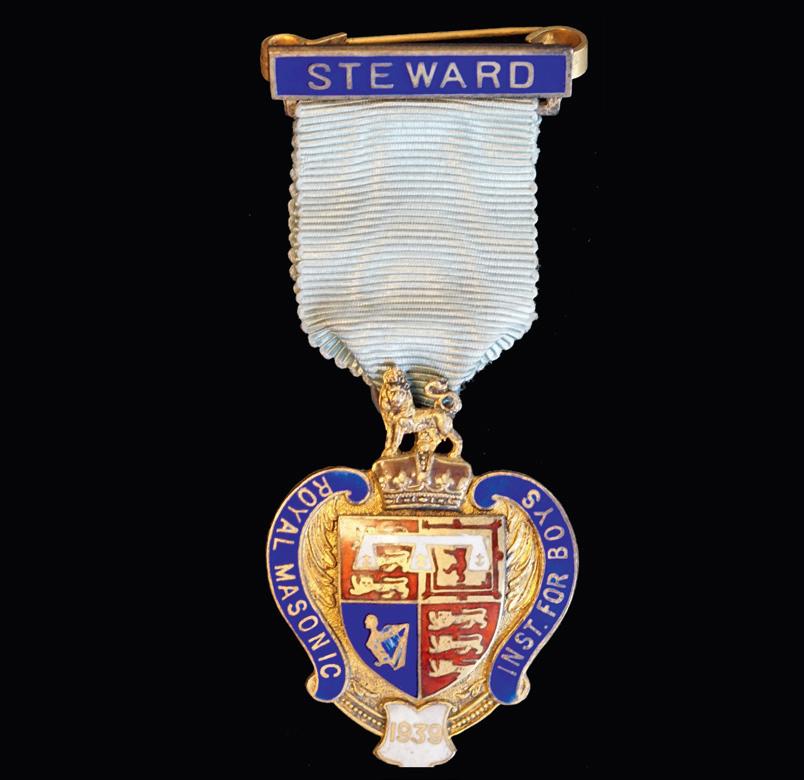
the RMIG Festival of 1914 and the RMIB Festival of 1930. The jewels for both were traditional, in that they were suspended from ribbons, and were similar in that each had an embellishment to the ribbon (a Royal crown surmounted by a lion in the case of the former and Prince Arthur’s cypher within the garter in the latter – he was made a Knight of the Garter in 1902), but the main design differed significantly. For 1914, the central design was his coat of arms within the garter, while for 1930 it was the Star of the Order of the Thistle, with which he had been invested in 1913.
Although not strictly a royal, the Earl of Harewood was the husband of Princess Mary, Princess Royal (only daughter of King George V and Queen Mary) and he, too, presided over two Festivals, those of the RMIG in 1932 and the RMIB in 1943. The main part of the jewel is similar in each case, a cross patonce within the garter, above the white rose of Yorkshire. The Earl of Harewood was Provincial Grand Master of Yorkshire, West Riding from 1926 until he succeeded the Duke of Kent as Grand Master, on the latter’s death in 1942. The jewel illustrated is made of metal and was issued as a replacement for the card token issued for Festivals during World War II.
HRH Prince George, Duke of Kent (father of our current Grand Master), took over from the Duke of Connaught as Grand Master in 1939 and agreed to preside over the RMIB Festival for that year. The design of the jewel featured his coat of arms, but events conspired to prevent him from acting as the Festival’s Chairman.
The RMBI jewel for the 1942 Festival, which was presided over by Prince George, is also again a replacement issued after the war and is of a fairly simple design, with his coat of arms within the garter. It is superficially similar to the RMBI design for 1931, the Festival presided over by Prince Albert, Duke of York (later King George VI). While Duke of York, he had also presided over a successful Festival for the Grand Lodge of Mark Master Masons’ Benevolent Fund (MBF) in 1934; the token was a lapel badge rather than a breast jewel, as is invariably the case with the MBF.
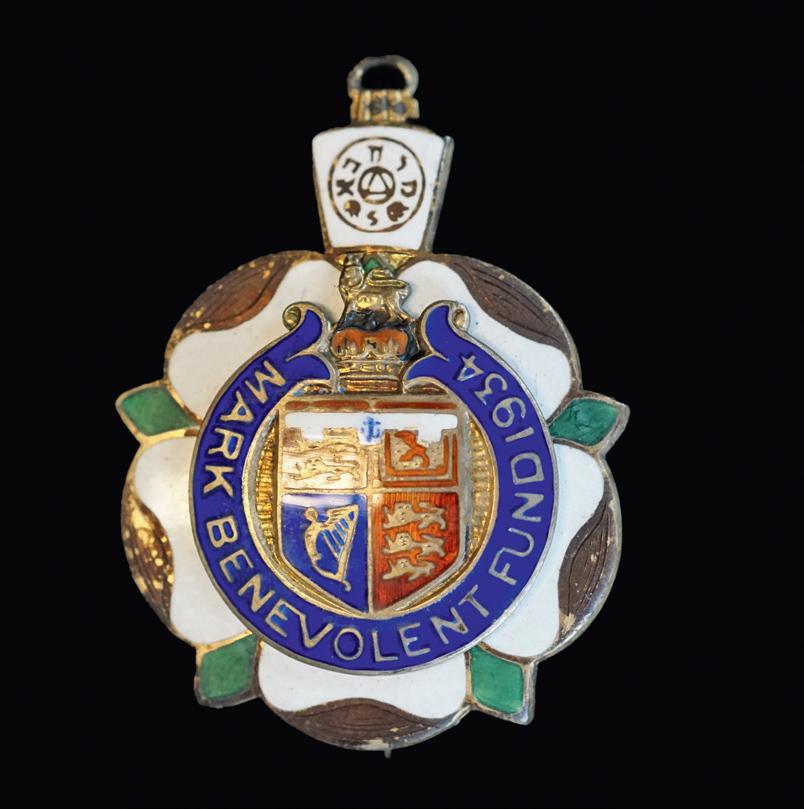

These members of the Royal Family are not the only Festival Presidents who have worked tirelessly to raise extraordinary sums of money for Masonic charities, often in adverse circumstances. They should, however, be an example to all of those who follow in their footsteps.
Anyone wishing to view any of the many Festival jewels held by the Museum can do so by giving 72 hours’ notice via e-mail at: contact@museumfreemasonry.org.uk
Clockwise from left: Featuring the Royal coat of arms and the Prince of Wales’s feathers, this jewel was struck by the Board of Governors of the RMIB in 1900 to commemorate the opening of the new buildings at Bushey by the Duke of Connaught; lapel badge for the Festival for the Grand Lodge of Mark Master Masons’ Benevolent Fund (MBF) in 1934; jewel for the 1932 RMIG Festival, presided over by the Earl of Harewood


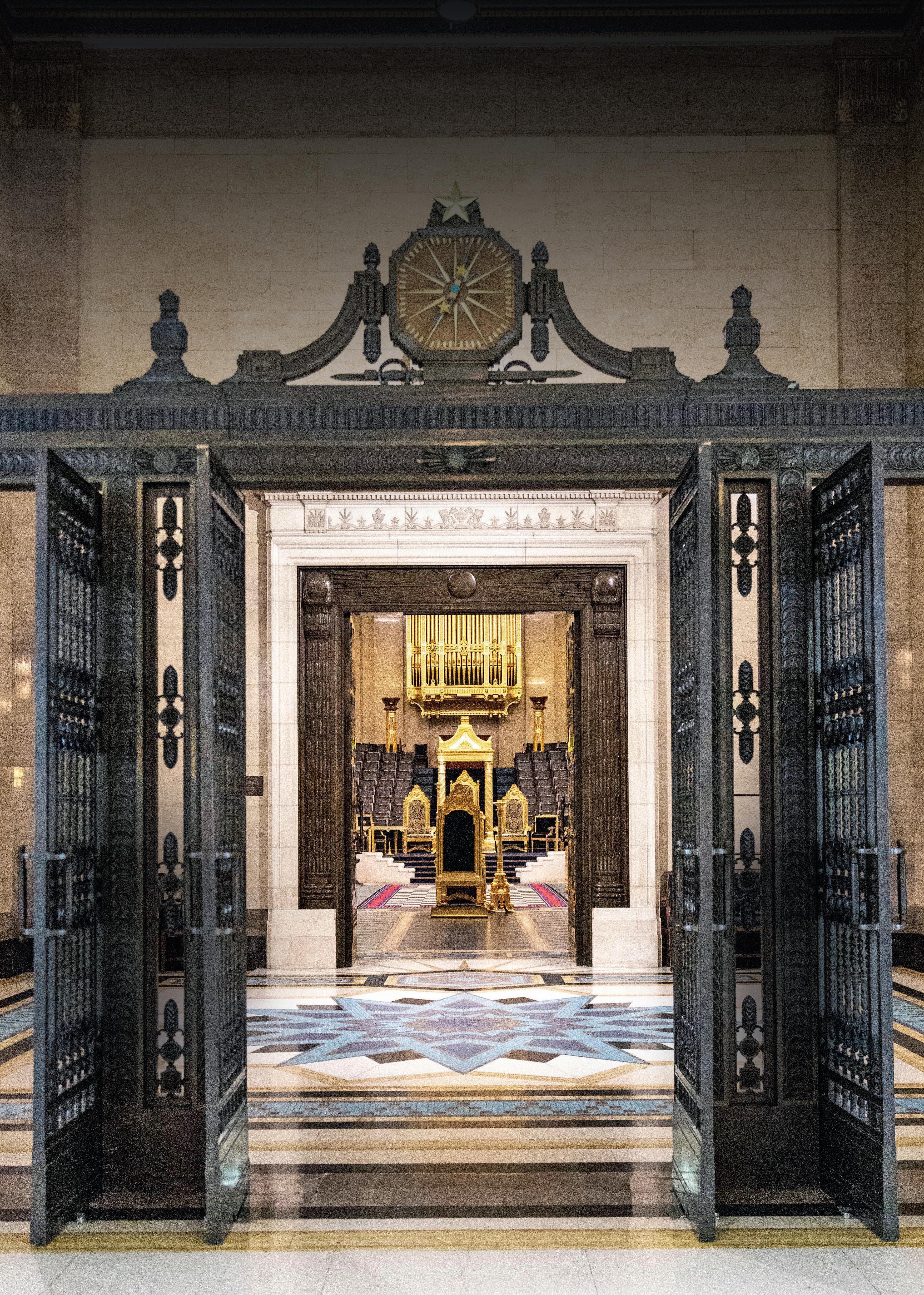
In his Quarterly Communication address to Grand Lodge in June, Pro Grand Master Jonathan Spence reflects on the crucial role of the Provinces in implementing the new Strategy

Brethren, it is very good to see so many of you here, notwithstanding the attractions available on a fine summer’s day.
I always think of this Quarterly Communication as something of a transitional moment in the rhythm of the Masonic year. This is the first Communication after the Annual Investiture and is the first occasion when the new Grand Officers of the Year, under the careful tutelage and watchful eye of the Grand Director of Ceremonies and his team of Deputies, discharge their duties in Grand Lodge. I think we can all agree, Brethren, it has been a very encouraging start and bodes well for the rest of their term of duty.
This Communication, however, also sees most of us think of the end of the current Masonic year, where many Lodges and Chapters have a break over the hot months of the summer, although I am aware there are a number of Provinces where this
does not occur, and Lodges and Chapters are as busy as ever. It is, therefore, a moment for reflection for all of us.
It is nine months since I was installed as Pro Grand Master and six months since we launched the ‘Strategy for Freemasonry, 2022 and beyond’ and it has been a busy time for everyone in Grand Lodge and in all the Provinces and Districts. I am grateful, Brethren, for all the support I have received from you and my fellow rulers in my new role.
I am grateful to Provincial Rulers and their teams for the tremendous amount of work that has been, and is being, put into articulating the Membership Challenge for each Province and engaging with their Lodges and Chapters to make it real for our members. We have seen some excellent addresses recently at Provincial meetings where this has been the core message with a high level of encouragement for members to take the lead in their own Lodges and Chapters.
These addresses are being shared among Provincial Rulers, both as examples of very good practice others can use, and to demonstrate this is a team effort at all levels. In order to deliver the Strategy and tackle the Membership Challenge, every single member has a part to play, and it is the responsibility of Provinces, Districts and Grand Lodge and Grand Chapter to give our members the tools to succeed.
You will now be very familiar with the Royal Arch being an integral part of the Strategy’s approach, and I hope many of you will have seen the Discover More booklet. There is more to come from the Committee of General Purposes with the planned launch of Archway in the autumn. In the interim, I would like to say something about the Royal Arch representatives in Craft Lodges.
I think it should be clear that to ensure the success of the Strategy, an effective Royal Arch representative in almost every Lodge is now even more important. This is a role that is critical to the Strategy for helping to increase Royal Arch membership. Since this post was first introduced, different Provinces and Districts have developed their own ways of handling these appointments, and I firmly believe that it is not for us ‘in the centre’
to interfere too much where a successful scheme has already evolved or can be worked out locally. However, given the importance of this role in representing the Order within a Lodge, I do believe that any companion nominated to be a Royal Arch representative should ultimately meet the approval and receive the support of his Provincial or District Grand Master (and of course his relevant Grand Superintendent) in order for him to be able to enjoy the appropriate status of the role and to carry the responsibilities that go with it.
I am assured that further guidance to support Royal Arch representatives in their tasks, along with examples of good practice, will be available on Archway when it is released later this year.
Brethren, you will know that the September Quarterly Communication will be held in Monmouthshire, exactly 100 years since this first happened when the Communication in September 1923 was held in Liverpool. I will say more about this in September, but I hope it is clear the Rulers and Grand Lodge really do believe in seeing if we can get things to work that are a little different to the established norms, building on an excellent base, with small incremental steps. I very much hope it will be a success, but as the Grand Master himself said, ‘We will not know unless we try.’
Brethren, I am enthusiastic about our prospects, I am encouraged by the way you are responding to the challenge, and I have no doubt we can succeed if we all work together to ensure we continue to thrive.
Thank you very much Brethren and I wish you all a pleasant and relaxing summer.
‘I am encouraged by the way you are responding to the challenge, and I have no doubt we can succeed if we all work together’
Introducing the Membership and Communications Working Party (M&CWP), which will support the implementation of UGLE’s Strategy for Freemasonry, 2022 and Beyond


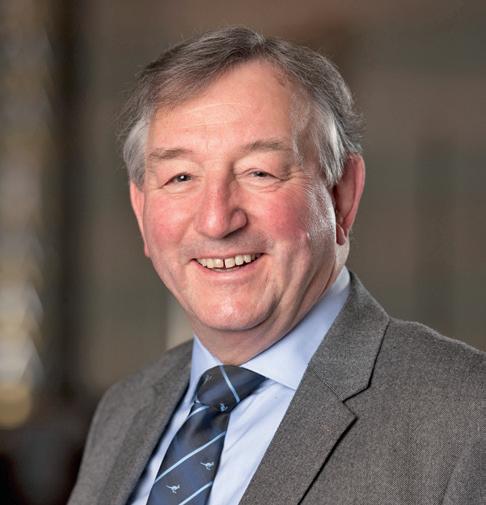
Reporting to both the Board of General Purposes and the Pro Grand Master, the M&CWP aims to identify, develop and share effective practices among members, Lodges and Provinces for attracting, engaging and ultimately growing the membership.

The M&CWP builds upon and consolidates the work of the Communications and Marketing Working Party and the Membership Working Party, which comprises the Members’ Pathway Working Party, Learning & Development, and the Universities Scheme Committee.
The M&CWP will develop options and prioritise actions to achieve the strategic objectives outlined in the ‘Strategy for Freemasonry, 2022 and Beyond,’ while also learning from the membership development strategies employed by Provinces and sharing innovative and successful practices.
In determining the most effective ways to engage with Provinces, Metropolitan Grand Lodge, Lodges and members, the M&CWP will explore the benefits of direct communications with the membership.
Representative for RCG 1
The North (Cumberland & Westmorland, Durham, Yorkshire N&E Ridings, Yorkshire West Riding, Northumberland)
Provincial Grand Master of Yorkshire North & East Ridings
Representative for RCG 2
North West Corner (East Lancashire, West Lancashire, Isle of Man, Cheshire, North Wales)
Provincial Grand Master of East Lancashire
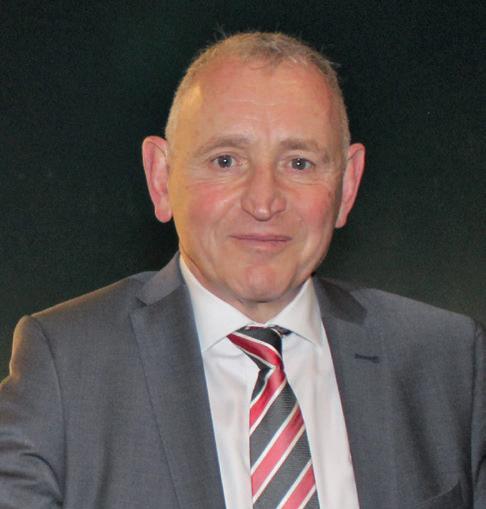
Representative for RCG 3
West Midlands (Shropshire, Staffordshire, Worcestershire, Warwickshire)
Provincial Grand Master of Worcestershire
Representative for RCG 4
South Wales and the West (Gloucestershire, Herefordshire, Monmouthshire, South Wales, West Wales, Bristol)
Provincial Grand Master of West Wales
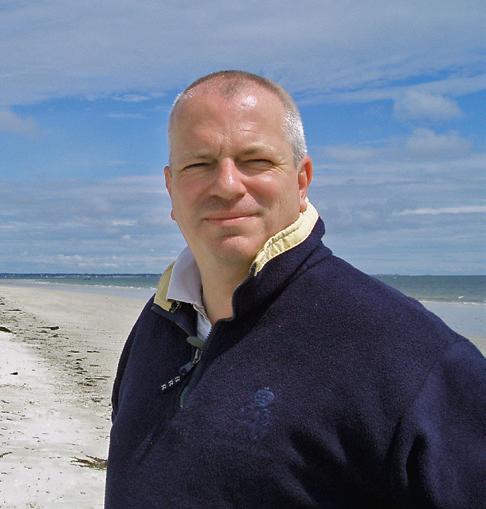
Anthony Howlett-Bolton
Representative for RCG 5 The Thames Valley (Berkshire, Buckinghamshire, Middlesex, Oxfordshire)
Provincial Grand Master of Berkshire and Chair of Learning and Development
Ian Copestake
Representative for RCG 6 East Midland Forum (Bedfordshire, Derbyshire, Leicestershire and Rutland, Lincolnshire, Nottinghamshire, Northamptonshire & Huntingdonshire)
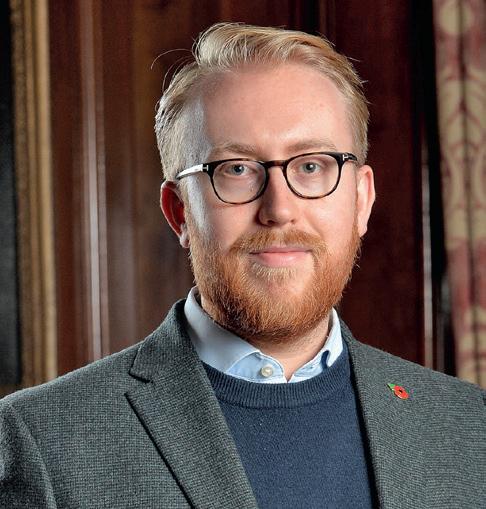

Provincial Grand Master of Derbyshire and Chair of the Members’ Pathway
Representative
East Anglia and Hertfordshire (Cambridgeshire, Essex, Hertfordshire, Norfolk, Suffolk)
Provincial Grand Master of Hertfordshire
Representative for RCG 8 South East (East Kent, West Kent, Surrey, Sussex)
Provincial Grand Master of West Kent
Graham Glazier
Representative for RCG 9 South West and Islands (Devonshire, Cornwall, Somerset, Hampshire and Isle of Wight, Wiltshire, Dorset, Guernsey and Alderney, Jersey)




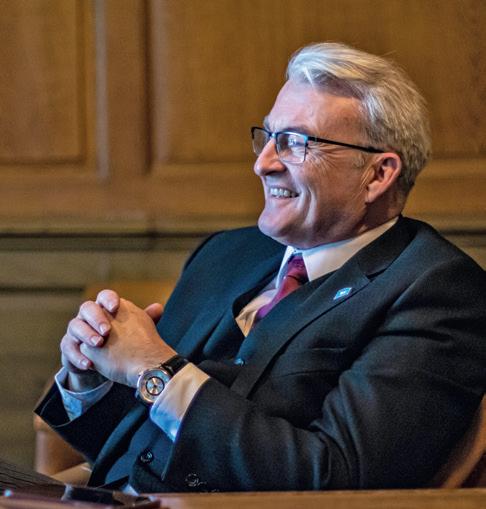

Provincial Grand Master of Dorset
Matt Hampson
Representative for Metropolitan Grand Lodge of London
Deputy Metropolitan Grand Master
While the Members’ Pathway provides a framework of information, it requires ‘Action’ in order to provide ‘Change’ in any Lodge or Chapter. Here, we highlight one Lodge’s journey to improve attendance at their Lodge of Instruction.
The Lodge Membership Team initially sought to identify the problem. By asking their non-attending members to be candid and honest, they quickly established that the general consensus was that: LOIs had become unstructured and followed a repetitive routine; LOIs lacked educational content; there was a need for more social events; and in general, their newer and younger members had needs and expectations which were not being met.
The Lodge Membership Team were determined to bring about change and meet those expectations. They set up a WhatsApp group, publishing the proposed LOI programme of work in advance. This immediately improved internal communications, providing structure and advance notification. It gave time for members to prepare and a forum for them to engage with each other. It encouraged attendance, but importantly gave an opportunity to provide advance apologies. Post LOI praise and encouragement increased the sense of belonging.
Mixing up regular practice sessions with educational pieces from Solomon greatly assisted,
but it was the introduction of more regular social events outside the Lodge environment that proved to be the key factor in meeting their needs. It quickly became apparent that more bonds were formed over a meal out at a local restaurant than at LOI.
The results have been simply staggering in terms of improved member attendance. By posting activities on their website and on Provincial social media, the Lodge has attracted both new and joining members looking to join in.
This example of good practice by a Lodge Membership Team dovetails nicely with the principles of the Members’ Pathway. Here, we see the following key objectives being met.
‘Understanding your Lodge’
‘Expectation management’
‘Guided learning’, ‘Personal learning’ and ‘Solomon’
‘Participation’ and ‘Understanding’
‘Tracking attendance & apologies’
‘Engaging with non-attending Members’
‘Understanding REAL reasons for losses’ and ‘Lessons learnt from losses’
‘Fun & Enjoyment’
Freemasonry is fun and will thrive, provided we recognise the needs of our members and react accordingly to meet them.







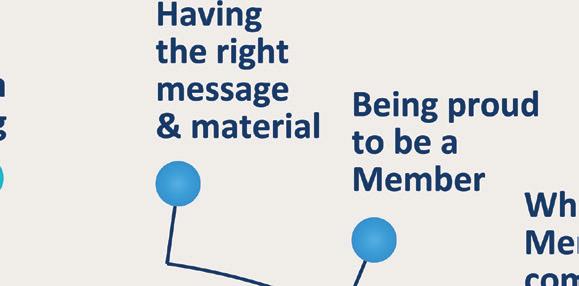















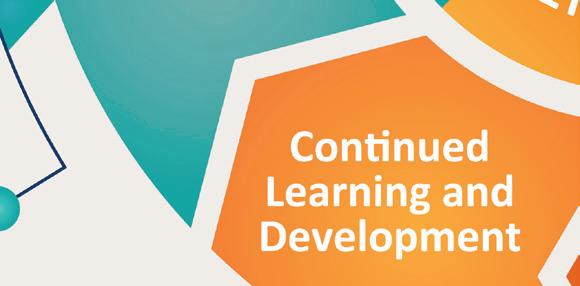
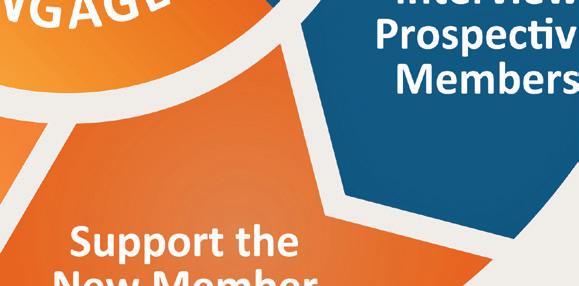



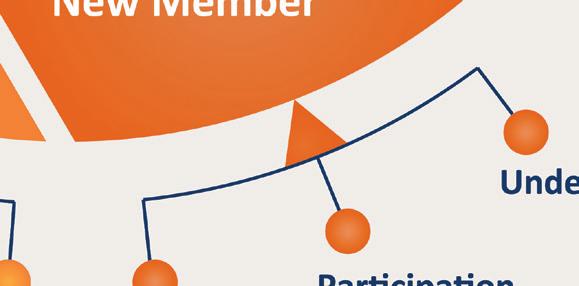





















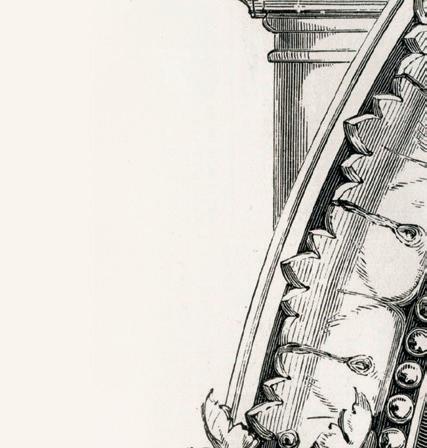


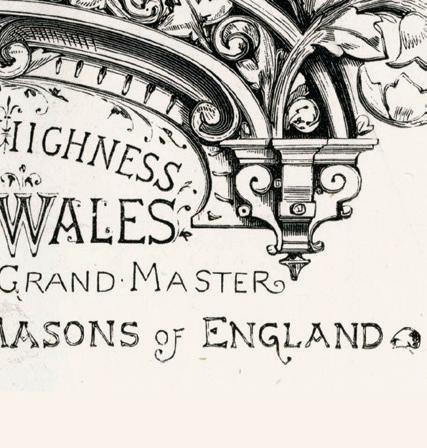
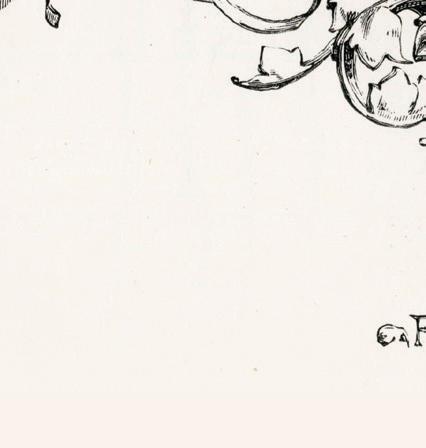








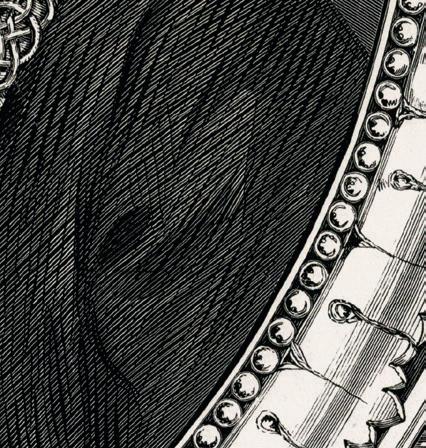

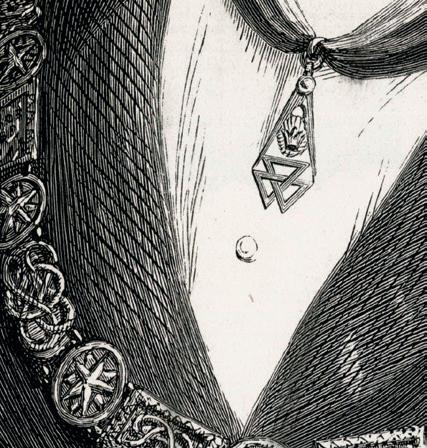
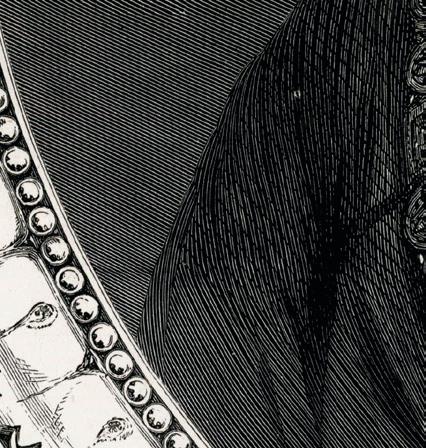


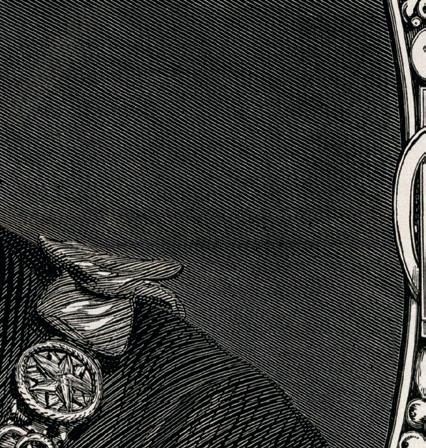
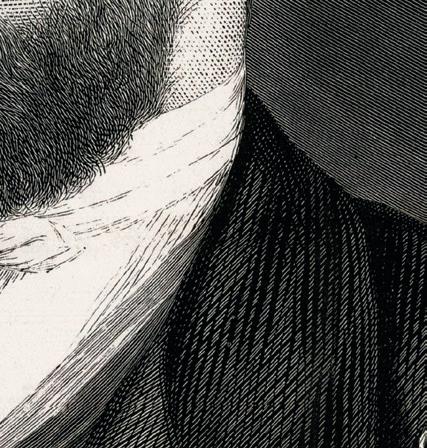
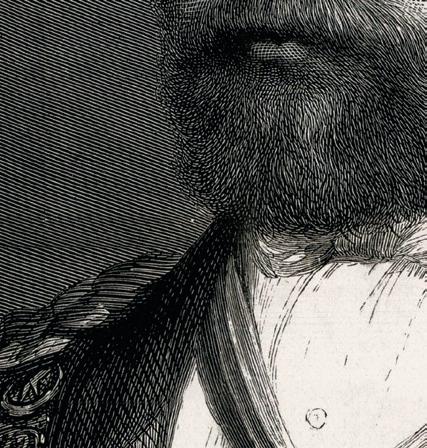
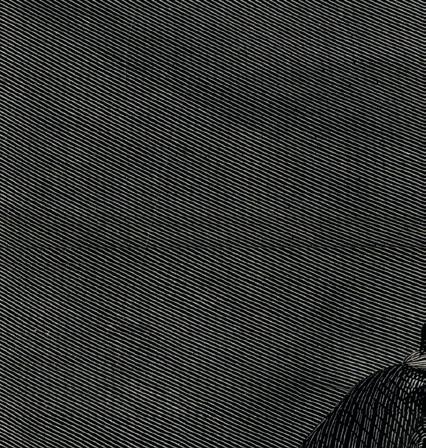
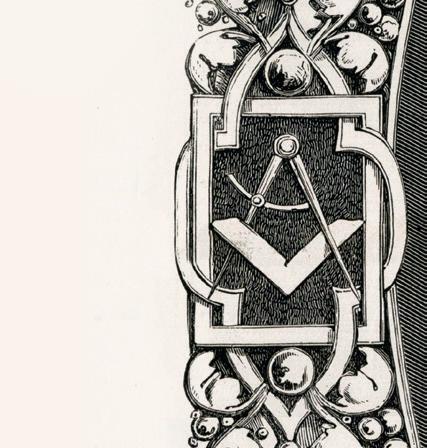
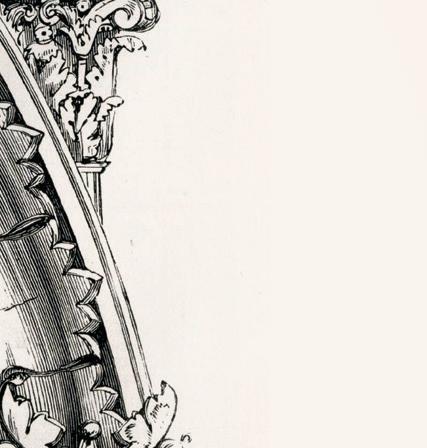
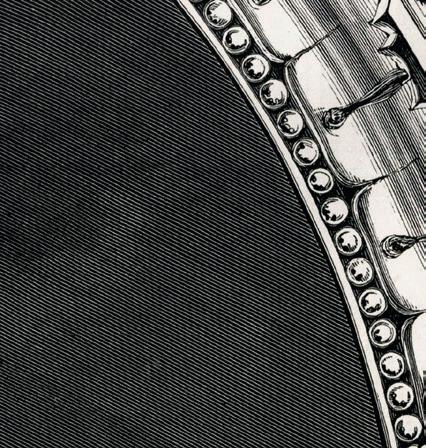
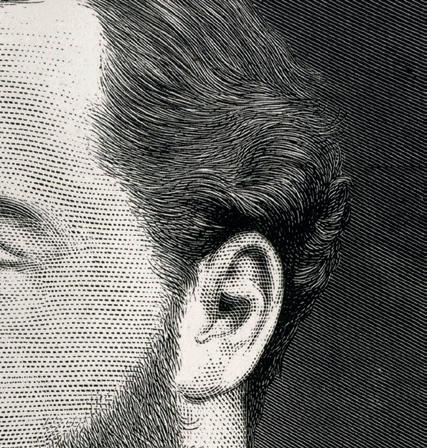

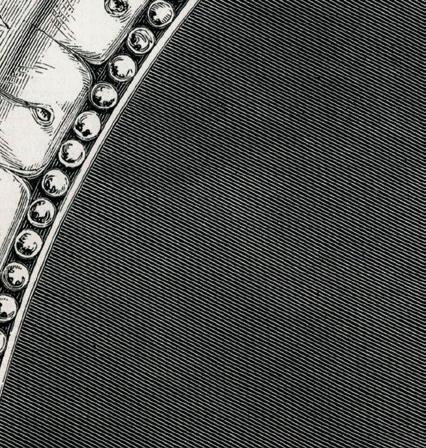








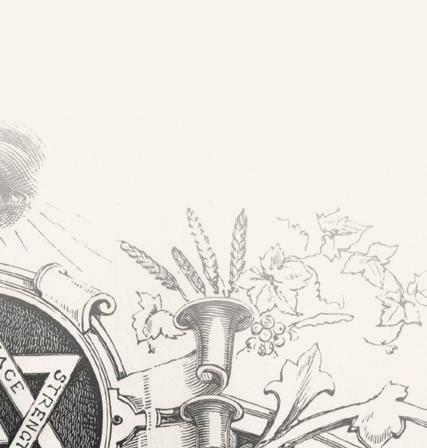
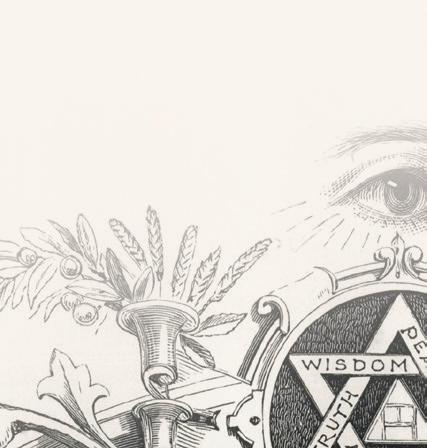









This First Grand Principal’s Jewel was made for Albert Edward, Prince of Wales, in 1874 by HT Lamb and Co, London. The 18ct gold jewel follows the official Royal Arch design – an Eastern Crown on a sunburst between compasses, under which are suspended three interlaced triangles.
In addition, the jewel is surmounted by a Royal Crown of gold and red enamel. Both crowns are decorated with diamonds and pink sapphires, while a larger diamond decorates the hinge of the compasses. The jewel is part of a collection of the Prince of Wales’s regalia looked after by the Museum of Freemasonry.

The future Edward VII was installed
as First Grand Principal of the Supreme Grand Chapter of England on 5 May 1875 and ruled the Royal Arch until he became King in 1901. Curiously, the Prince was not a member of a Royal Arch Chapter in this country when he was installed as First Grand Principal, but qualified because he was initiated in Sweden in 1868, and was therefore a member of all the degrees of the Swedish Rite, including the Royal Arch.
No images exist of Albert Edward in full Royal Arch regalia, but there are several photographs of him wearing the jewel with Craft regalia, such as the one taken with his son, Albert Victor, in 1886 (left).


In my last column, I announced the introduction of a dedicated mental health support service for children aged five and up. Since the launch, we have supported 30 children with their mental health journeys. This service fills a crucial gap in accessing state provision and offers vital support to young individuals facing mental health challenges. I am delighted that Freemasonry, through the Masonic Charitable Foundation (MCF, the Freemasons’ charity), is able to offer such an important service, which for some is a lifeline.
In the autumn, we launched the MCF Hospice Bursary scheme, aimed at enhancing staff retention and development. This initiative provides bursaries for staff training within hospices. We have awarded 97 bursaries to 58 hospices across 29 Provinces. The enthusiastic response from the hospice community reflects the value and importance of this scheme. By investing in staff training, we ensure hospice teams receive the necessary skills and knowledge to provide optimal care and support to those in need.
Our two-year strategic partnership with the Cranfield Trust aims to provide intensive support to charities through consultancy, mentoring and raising awareness about effective charity management and skilled volunteering. In the first year of the programme, significant progress has been made, with 24 intensive
consultancy and mentoring assignments delivered. In addition, 63 charity leaders were supported through peer-to-peer exchanges, and more than 2,600 charity leaders have attended 12 MCF-funded webinars. All Freemasons can be proud of the lasting legacy that this partnership is creating for small charities.

Freemasonry’s support for Ukrainians affected by conflict, mainly women and children, continues to have a positive impact. The British Red Cross, a key partner in our Ukraine appeal, recently updated us on its work assisting the 170,000 people displaced by the conflict who have arrived in the UK. Their efforts include providing resources at arrival centres, assisting with accessing vital services, and reuniting 463 individuals, mostly children, with their loved ones. Our heartfelt gratitude goes out to all who supported the appeal.
In recent months, we have successfully launched Festival appeals for the Provinces of Yorkshire, West Riding and Nottinghamshire, with celebrations marking the conclusion of appeals for Devonshire, Worcestershire and Berkshire. Despite the challenging cost-of-living crisis, the average per capita donation across all Provinces stands at an impressive £729. This is a testament to the generosity of our members and the dedication of our Lodge Charity Stewards and other fundraisers. Later this year, we will celebrate the conclusion of the Cambridgeshire and Warwickshire Festival appeals, and I wish both Provinces every success during the final months of their efforts.
I also extend thanks to the MCF Ball committee for its annual event. The 2023 Ball, jointly hosted and supported by the Provinces of Bristol and Somerset, was a memorable event with more than 500 attendees, raising awareness and funds for the MCF. The 2024 Ball will be supported by the Province of Lincolnshire and will be held in Lincoln.
At our annual trustees dinner, we expressed gratitude to several retiring board members, most of whom also served with the central charities prior to the creation of the MCF. Their years of service have played a crucial role in establishing our charity and we thank them for their dedication. Additionally, we bid farewell to Katrina Kerr, formerly Head of Charity Grants and a valuable member of the Senior Leadership Team. Katrina’s contributions were instrumental in creating our Charity Grants programmes and we extend our appreciation for her many years of devoted service. We wish all departing members well in their future endeavours. We remain dedicated to our mission of building better lives for those in need and our shared vision of becoming a force for good in our communities, and I am grateful for the unwavering generosity of Freemasons in supporting our work.
Dementia is on the rise. That’s why the Freemasons’ charity is funding sessions to help those with the condition to live well and thrive
Around 900,000 people living in the UK have been diagnosed with dementia – and this figure is expected to increase by 16 per cent over the next few years. With an ageing population and dementia on the rise, the Masonic Charitable Foundation (MCF, the Freemasons’ charity) is continuing to prioritise later-life initiatives by offering charitable grants to communities in need to confront the challenges faced by older adults.
According to Age UK and Alzheimer’s Society research, people with an existing dementia diagnosis experienced worsened symptoms because of lockdowns and contracting COVID-19. In the wake of the pandemic, 82 per cent of people with dementia reported
a decline in their condition. Memory loss, agitation and problems with concentration were all heightened, both in the immediate aftermath and in the longer term.
Despite many symptoms worsening and diagnoses rising, there is still a stigma around getting a timely diagnosis. Many barriers hinder individuals seeking help. These include the misconception that memory loss is just a sign of getting older, the denial and concerns about the long wait times to see a specialist. However, 91 per cent of people who have already received a diagnosis fi rmly advocate the importance of knowing.
Given the prevalence of the condition, the MCF has been targeting its funding towards dementia charities over the past few years. Among them is Bright Shadow,
which supports individuals with dementia, enabling them to live well and thrive through creative weekly sessions that promote communication skills and independence, and which combat loneliness.
The impact of these sessions has been impressive. Feedback from participants reveals that at least nine in 10 beneficiaries reported feeling positive having meaningfully engaged in the activities on offer.
‘In the fi rst five months of the year, we provided 304 hours of short breaks for carers,’ says Clare Thomas, chief executive of Bright Shadow. ‘Participants tell us that their session is the highlight of their week and that it provides much-needed consistency and routine, a sense of community, and a chance to feel competent and in control. This all has a profound effect on people’s wellbeing.’
Funding from the MCF has played a crucial role in improving the wellbeing of many people living with dementia. Charities such as Trent Dementia have been instrumental in using these grants to address social isolation. Until now, the funding has enabled them to prepare 600 individual activity packs for people with the condition and those that support them. ‘The support from the MCF has been invaluable and has helped us to continue reaching out to people who are coping alone after a diagnosis,’ says Jane Rowley, project manager at Trent Dementia. With more families facing dementia diagnoses, knowing the best way to support a relative can be challenging. It is common for people with dementia to be spoken for by others, so it is vital to remember that the support you offer should always put the person fi rst. Instead of making assumptions about their needs, it is crucial to engage in an open dialogue and involve them actively in the conversation.
‘It’s easy to do things for those with dementia as it might be done quicker,’ says Ben Trowell, business development manager of Alive Activities, a charity also supported by the MCF. ‘But someone with dementia still needs a sense of achievement. So, support them with tasks, but don’t do it for them.’
Dementia is an umbrella term for various symptoms, often associated with memory loss resulting from brain damage caused by multiple diseases. But people’s experiences of dementia can also be varied and it is a common misconception that receiving a diagnosis means the end of meaningful life. In fact, people with the condition can live purposefully and actively for many years, especially if they stay involved with their community and build support networks. The MCF’s funding for these charities is crucial in enhancing the quality of life for people affected by dementia and addressing the stigma surrounding it.
Find out more about the impact of the MCF later-life programme by visiting mcf.org.uk/FMT63/Later-Life or scan this QR code
The cost-of-living crisis may feel like old news, but for most it is still a current issue. Inflation reached its peak at 11.1 per cent in October 2022 and has been slowly reducing. But many individuals, families and organisations are still suffering.
According to Charity Link, 71 per cent of charity leaders expressed concern about managing increased demand for their services. This has been a widespread pressure for organisations having to consider their budgets as they are being relied on more and more. To add to this, many that rely on donations from the public have experienced a reduction in contributions – unsurprising given the growing cost of everyday bills.
Thanks to the generosity of Freemasons and their families, the Masonic Charitable Foundation (MCF, the Freemasons’ charity) has

supported charities through grants – helping them to continue providing services that are needed.
Many organisations that applied for MCF grants at the height of the crisis expressed concern about the impact this would have on their budgets and the people they support. The Little Edi Foundation, an Essex-based charity that supports children and families facing poverty, is one such case. The organisation offers food boxes and household goods to families, and supplies
Wolves Foundation, the official charity of Wolverhampton Wanderers FC, has launched a new project called the Golden Wolves. The aim is to support more than 100 older people experiencing, or at risk of,

loneliness and social isolation due to factors such as mobility, financial constraints, housing situations, the loss of friends or family, and anxiety. The initiative was made possible by a £38,000 grant from the
new school uniforms and Clarks school shoes for children whose families cannot afford them. It also holds coffee mornings where families can choose clothes, books, toys, fruit and vegetables. There’s also a summer scheme where children can enjoy swimming, go-karts, a petting farm and sports activities.
The cost-of-living crisis left these families even more reliant on the charity, meaning its services became stretched. The Little Edi Foundation
Masonic Charitable Foundation (MCF, the Freemasons’ charity).
The project will feature four-hour sessions held at locations across the city, including Molineux Stadium, community centres, Gurdwaras and village halls. Each session will offer a range of activities to foster social connections and encourage new relationships.
Wolverhampton is in the top 25 most deprived local authorities in the UK, with 23 per cent of older adults living in poverty and 41 per cent living alone. The city also has many ethnically diverse communities, which can create further barriers to building social connections.
reached out to the MCF and was awarded a grant of £5,000, which allowed it to continue helping more than 60 families.
‘I’m really pleased we’ve been able to help the Little Edi Foundation through this difficult financial period,’ says Les Hutchinson, Chief Executive of the MCF. ‘Since the pandemic, more and more families are slipping below the poverty line. Now, one in three children in the UK are living in poverty. Organisations like these are a lifeline, so it’s important that their services continue to be delivered. This would not have been possible without the generosity of Freemasons and their families.’
Subscribe to the MCF’s newsletter for updates about its work. Scan the QR code or access mcf. org.uk/FMT63/subscribe
Rachel Smith, health and wellbeing manager at the Wolves Foundation, says, ‘We’re extremely grateful for the full funding provided by the MCF. The grant will enable us to reach even more older people in need of support and companionship.
‘We’re proud to be working with them to positively impact our community.’
Find out more about how the MCF supports charities in your area by visiting mcf.org.uk/impactFMT62 or scan the QR code.




District
Bridgetown
District
The
Freetown/Banjul
District Grand Lodge of Sierra Leone & The Gambia (21 Lodges)
Accra
District Grand Lodge of Ghana (58 Lodges)
Lagos
District Grand Lodge of Nigeria (42 Lodges)
Nairobi
District Grand Lodge of East Africa (48 Lodges)
Johannesburg
District Grand Lodge of South Africa, North (101 Lodges)
Kimberley
District Grand Lodge of South Africa, Central Division (8 Lodges)
Windhoek
District Grand Lodge of Namibia (4 Lodges)
Cape Town
District Grand Lodge of South Africa, Western Division (30 Lodges)
Ndola
District Grand Lodge of Zambia (11 Lodges) Harare/Lilongwe
District Grand Lodge of Zimbabwe & Malawi (12 Lodges)
Durban
District Grand Lodge of Kwazulu-Natal (26 Lodges)
Bloemfontein
District Grand Lodge of Orange Free State (7 Lodges)
Port Elizabeth
District Grand Lodge of South Africa, Eastern Division (28 Lodges)
9.
Mumbai
District Grand Lodge of Bombay (23 Lodges) New Delhi
District Grand Lodge of Northern India (5 Lodges)
Kolkata
District Grand Lodge of Bengal (23 Lodges)
Chennai
District Grand Lodge of Madras (18 Lodges)
Colombo
District Grand Lodge of Sri Lanka (10 Lodges)
11. AUSTRALIA
Albany
Plantagenet Lodge, No. 1454
Melbourne Combermere Lodge, No. 752
Tully
Geraldton Lodge, No. 3544
Gladstone Port Curtis Lodge, No. 2235
Kuala Lumpur/ Singapore/Thailand
District Grand Lodge of Eastern Archipelago (40 Lodges)
Hong Kong/Kobe
District Grand Lodge of Hong Kong & The Far East (20 Lodges)
Vanuatu/Fiji
The Group of Lodges in the South West Pacific (3 Lodges)
Rabaul
Rabaul Lodge, No. 4468
Christchurch
District Grand Lodge of South Island, New Zealand (13 Lodges)
Auckland
District Grand Lodge of North Island, New Zealand (24 Lodges)

@freemasonry2day
@ugle_grandlodge
@grandchapter
1 March
@LondonMasons
London Freemasons pledge
£3m support for @LDNairamb ‘Up against time’ £15m appeal. ‘London’s Air Ambulance is an essential part of keeping London safe, our pledge today will help this continue for many years to come.’
5 May
@provgchstwdox
On Monday, our TLC scheme will be donating around 500 teddies to children at the Oxford, Horton, Abingdon, Henley and Witney hospitals. We’re being interviewed on BBC Radio Oxford at 9.15, 8 May to talk about the scheme. @Masonic_Charity @OxfordshirePGL
18 May
@PGLDurham
Provincial Grand Chapter of Durham on tour once more. This time we are in Carlisle for the Annual Convocation of The Provincial Grand Chapter of Cumberland and Westmorland.
FreemasonryToday
UnitedGrandLodgeofEngland
SupremeGrandChapter
26 May
@PGLSomerset
Announcement from @ TheAdairClub. The Somerset Light Blues Club for new and young #Freemasons is proud to release the first episode of the PodCraft #podcast!
@unitedgrandlodgeofengland
@freemasonrytoday
@freemasonsha ll
9 July
@ChritonS
The @WorcsMasons annual cathedral service at Worcester today. Such an amazing setting.

11 July
@HantsMasonSE
entertainers, and everyone else who made the night such a success.
26 June
@SouthWalesMason
South Wales Freemasons donate £120,000 to

@ProstateCymru

17 June
@Shaun_UGLE
Delighted to have joined #Lodge10k last night with @imJamesDalton, @whatley_ stephen and a visiting @MitchellBryan! Great to see @Mattypro3, @whatleystephen3, @MarkConstant4, @fergussonjohnd and many more!
@dglsand
Guanabara Chapter, 5557, recently celebrated a significant milestone with its 300th meeting, which included a warm welcome for a new companion.
20 June
@Masonic_Charity
23 May
@ProvCornwall
39 Cornish charities share in £120,000 donation by Cornish Freemasons at the annual Charity Giving Day event.

On Saturday night, @PGL_Bristol and @PGLSomerset hosted the epic annual MCF Ball to celebrate the work of Freemasonry and the MCF and raise some additional funds. Thank you to the fantastic party-goers,
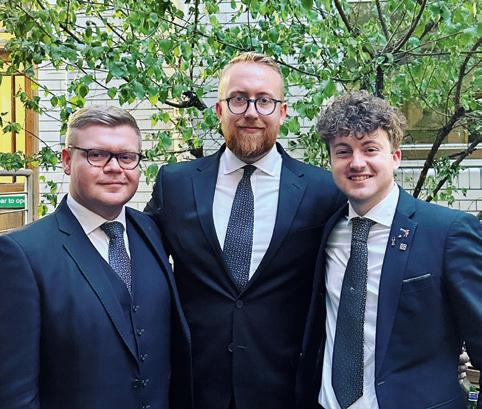
#prostatecancer
#CharityMatters
@UGLE_GrandLodge
5 July
@dglofmadras
Last month, members of Lodge of Rock No. 260 EC engaged in a friendly cricket match in Tiruchirapalli alongside other Lodges in the city. This was an excellent opportunity for the brethren to relax, bond, & foster camaraderie.
@UGLE_GrandLodge
A great start to the tenure of our new APGM, W Bro Chris Bayliss, with a fantastic effort from Lodges within the
area with cheques totalling over £49,000, presented to charities at our annual presentation evening. Throughout the year, this rose to a HUGE £109,290!
13 July
@westkentmasons
Good to catch up with key members of the UGLE team at the recent #Hampshire and #IsleofWight Provincial meeting in #London, who do so much to assist with many of our Communications and Membership development activities.
16 July
@wiltspgl
If you want a reason why you should think about becoming a Wiltshire Freemason – there can be no better person to give one than the Head of Wiltshire Freemasonry John Reid. Just ask at pglwilts.org.uk/contact
Very few images exist of the Quarterly Communication held in Liverpool in September 1923 – even though it was the first time it had been held outside London. Grand Lodge meetings were conducted behind closed doors, so this cartoon by Hershey Woods offers a rare glimpse behind the scenes. Woods, who died in 1961, was a clerk at Freemasons’ Hall and a member of Letchworth Lodge. He was also a gifted cartoonist and the Museum is blessed with several of his observations on the lives of staff at UGLE.


